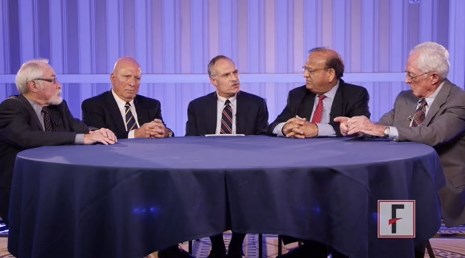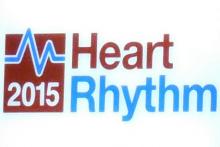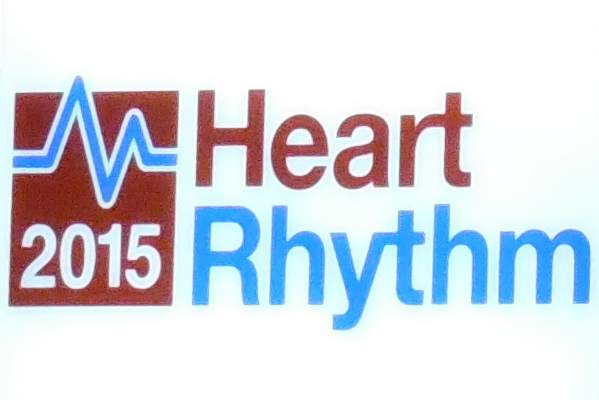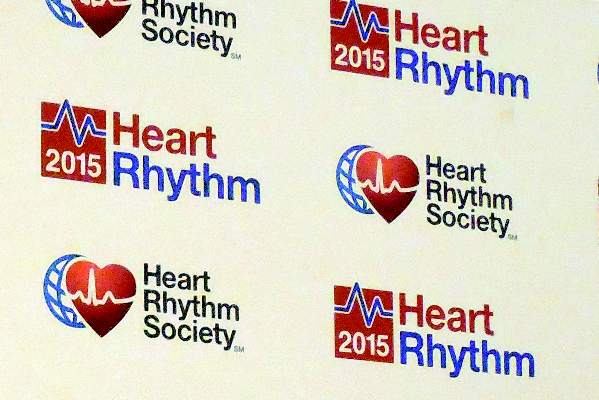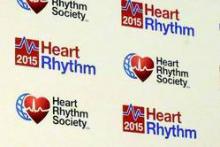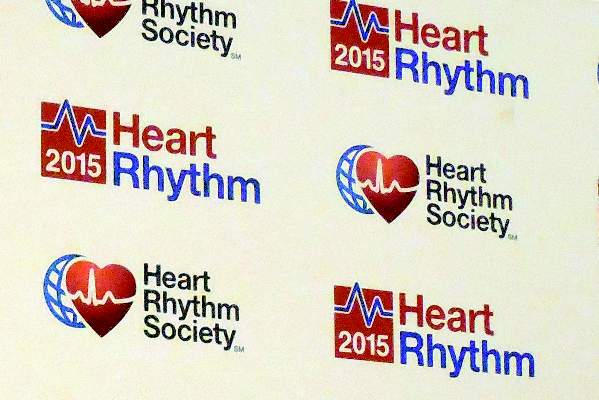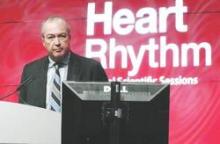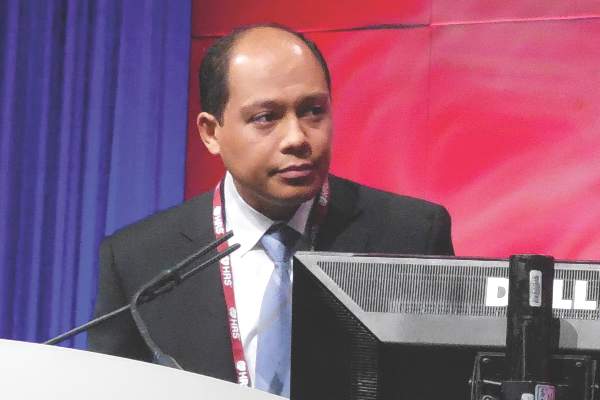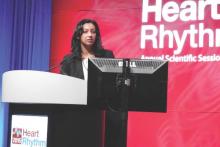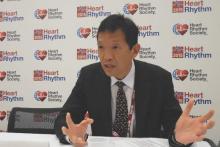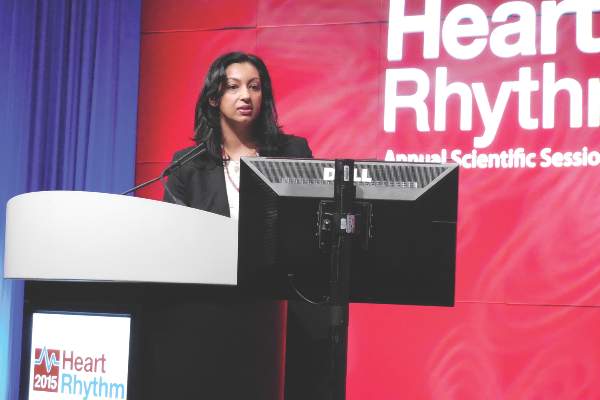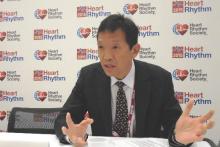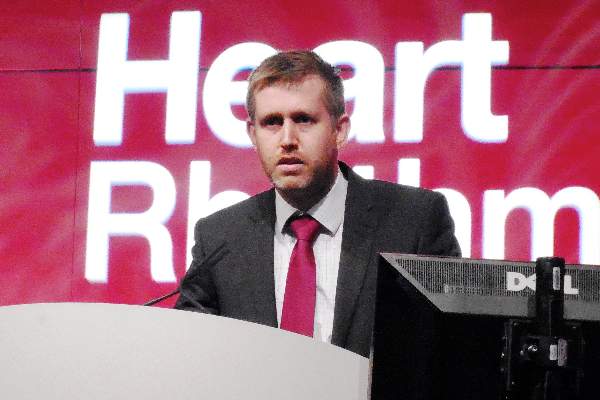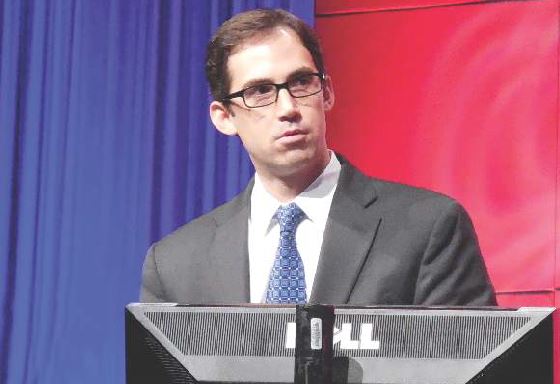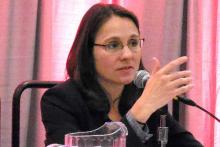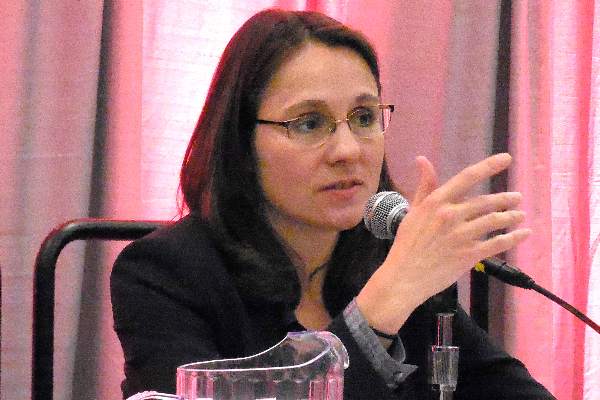User login
Heart Rhythm Society (HRS): Heart Rhythm 2015
HFSA Roundtable, part 1: Beta-blockers remain heart failure management linchpin
NATIONAL HARBOR, MD. – More than 20 years ago, treating chronic heart failure patients with a beta-blocker drug seemed counterintuitive, but it turned out to be a landmark step, both for clinical efficacy and for improved understanding of the role neurohormonal drivers play in chronic heart failure.
The Heart Failure Society of America awarded its annual Lifetime Achievement Award to Dr. Sidney Goldstein during the its annual meeting in September. On the occasion of that award, we gathered Dr. Goldstein and some of his associates to discuss the beta-blocker legacy and other aspects of how heart failure treatments developed and where they stand today. Joining this round table were Dr. Jay N. Cohn, Hani N. Sabbah, Ph.D., and Dr. Prakash Deedwania.
In this first segment of the interview, the panel reminisced about how a rationale gradually developed supporting the principle behind beta-blockers and other neurohormonal interventions for heart failure, and they discussed how the explanation of beta-blocker activity in heart failure patients remains controversial even today.
Despite a track record of consistent efficacy across drugs in the beta-blocker class that goes back some 2 decades, getting patients to their appropriate beta-blocker dosage remains a challenge, noted Dr. Goldstein, a cardiologist at Henry Ford Hospital and a professor of medicine at Wayne State University in Detroit. “Most heart failure patients whom I see on a beta-blocker are on far too low a dosage,” he said. Clinicians continue to believe that maximum dosing with a beta-blocker is nearly impossible, while in reality “if you advance the treatment, patients tolerate it quite well. There has always been this mystique about the tolerability of beta-blockers, but that’s pure fantasy,” Dr. Goldstein said.
Dr. Goldstein had no disclosures. Dr. Deedwania had no disclosures. Dr. Cohn receives royalties from Arbor Pharmaceuticals related to his work on hydralazine and isosorbide dinitrate. Dr. Sabbah is a consultant to Boston Scientific and an adviser to BioControl Medical, and he has received research grants from both companies.
The video associated with this article is no longer available on this site. Please view all of our videos on the MDedge YouTube channel
On Twitter @mitchelzoler
NATIONAL HARBOR, MD. – More than 20 years ago, treating chronic heart failure patients with a beta-blocker drug seemed counterintuitive, but it turned out to be a landmark step, both for clinical efficacy and for improved understanding of the role neurohormonal drivers play in chronic heart failure.
The Heart Failure Society of America awarded its annual Lifetime Achievement Award to Dr. Sidney Goldstein during the its annual meeting in September. On the occasion of that award, we gathered Dr. Goldstein and some of his associates to discuss the beta-blocker legacy and other aspects of how heart failure treatments developed and where they stand today. Joining this round table were Dr. Jay N. Cohn, Hani N. Sabbah, Ph.D., and Dr. Prakash Deedwania.
In this first segment of the interview, the panel reminisced about how a rationale gradually developed supporting the principle behind beta-blockers and other neurohormonal interventions for heart failure, and they discussed how the explanation of beta-blocker activity in heart failure patients remains controversial even today.
Despite a track record of consistent efficacy across drugs in the beta-blocker class that goes back some 2 decades, getting patients to their appropriate beta-blocker dosage remains a challenge, noted Dr. Goldstein, a cardiologist at Henry Ford Hospital and a professor of medicine at Wayne State University in Detroit. “Most heart failure patients whom I see on a beta-blocker are on far too low a dosage,” he said. Clinicians continue to believe that maximum dosing with a beta-blocker is nearly impossible, while in reality “if you advance the treatment, patients tolerate it quite well. There has always been this mystique about the tolerability of beta-blockers, but that’s pure fantasy,” Dr. Goldstein said.
Dr. Goldstein had no disclosures. Dr. Deedwania had no disclosures. Dr. Cohn receives royalties from Arbor Pharmaceuticals related to his work on hydralazine and isosorbide dinitrate. Dr. Sabbah is a consultant to Boston Scientific and an adviser to BioControl Medical, and he has received research grants from both companies.
The video associated with this article is no longer available on this site. Please view all of our videos on the MDedge YouTube channel
On Twitter @mitchelzoler
NATIONAL HARBOR, MD. – More than 20 years ago, treating chronic heart failure patients with a beta-blocker drug seemed counterintuitive, but it turned out to be a landmark step, both for clinical efficacy and for improved understanding of the role neurohormonal drivers play in chronic heart failure.
The Heart Failure Society of America awarded its annual Lifetime Achievement Award to Dr. Sidney Goldstein during the its annual meeting in September. On the occasion of that award, we gathered Dr. Goldstein and some of his associates to discuss the beta-blocker legacy and other aspects of how heart failure treatments developed and where they stand today. Joining this round table were Dr. Jay N. Cohn, Hani N. Sabbah, Ph.D., and Dr. Prakash Deedwania.
In this first segment of the interview, the panel reminisced about how a rationale gradually developed supporting the principle behind beta-blockers and other neurohormonal interventions for heart failure, and they discussed how the explanation of beta-blocker activity in heart failure patients remains controversial even today.
Despite a track record of consistent efficacy across drugs in the beta-blocker class that goes back some 2 decades, getting patients to their appropriate beta-blocker dosage remains a challenge, noted Dr. Goldstein, a cardiologist at Henry Ford Hospital and a professor of medicine at Wayne State University in Detroit. “Most heart failure patients whom I see on a beta-blocker are on far too low a dosage,” he said. Clinicians continue to believe that maximum dosing with a beta-blocker is nearly impossible, while in reality “if you advance the treatment, patients tolerate it quite well. There has always been this mystique about the tolerability of beta-blockers, but that’s pure fantasy,” Dr. Goldstein said.
Dr. Goldstein had no disclosures. Dr. Deedwania had no disclosures. Dr. Cohn receives royalties from Arbor Pharmaceuticals related to his work on hydralazine and isosorbide dinitrate. Dr. Sabbah is a consultant to Boston Scientific and an adviser to BioControl Medical, and he has received research grants from both companies.
The video associated with this article is no longer available on this site. Please view all of our videos on the MDedge YouTube channel
On Twitter @mitchelzoler
EXPERT ANALYSIS FROM HFSA
Beta-blockers remain a key part of treatment for chronic heart failure, and control of neurohormonal activation remains a central principle of treatment.
HRS: Blacks show higher A fib–stroke risk than whites do
BOSTON – Black people with new-onset atrial fibrillation have a 60% increased risk for stroke compared with white people who have incident atrial fibrillation when not maintained on an appropriate anticlotting regimen, according to prospectively collected data from more than 56,000 subjects at a U.S. center.
But in the subgroup of new-onset atrial fibrillation (AF) patients who received appropriate treatment with aspirin or an anticoagulant, the stroke rates among white and blacks equalized. The analysis showed that 46% of the more than 3,000 people who developed AF during follow-up received aspirin if their CHA2DS2-VASc score was less than 2, or anticoagulation with warfarin or a new oral anticoagulant if their score was 2 or greater, Dr. Parin J. Patel said at the annual scientific sessions of the Heart Rhythm Society.
The majority of the followed cohort with incident atrial fibrillation did not receive this treatment, and in the total group, the relative rate of stroke among blacks exceeded that of whites by a statistically significant 60% in an analysis that adjusted for several demographic and clinical features. The excess of strokes occurred at about the same rate in black women compared with white women, and in black men compared with white men, reported Dr. Patel, an electrophysiologist at the University of Pennsylvania in Philadelphia.
The implication is that because their stroke risk is greater, blacks with AF should especially receive appropriate stroke prophylaxis and AF therapy, he said. The overall findings also highlight the substantial stroke risk faced by all AF patients.
The data came from the University of Pennsylvania Atrial Fibrillation-Free study of 91,274 people who underwent an ECG examination in the University of Pennsylvania health system during 2004-2009 along with an index clinical encounter within 30 days. Excluding patients with a prevalent AF or other arrhythmia, prevalent stroke, or incomplete data left 56,835 AF- and stroke-free people to follow for incident AF, which occurred in 3,891 patients. At the time of AF diagnosis, the average age of patients was 63 years; more than a third had hypertension; a fifth had diabetes; and a fifth had heart failure. One-third of the incident-AF group was black, 58% were white, and the remainder were from other demographic groups.
Dr. Patel and his associates defined an AF-related stroke as any that occurred within 6 months before AF diagnosis or anytime after, which occurred in 645 (17%) of the incident-AF patients. The more than 50,000 AF-free people followed in the study had a total of 3,001 strokes not related to AF during follow-up, which meant that 18% of all strokes in the entire cohort were AF related.
Among the 645 AF-related strokes, roughly half occurred during the 6 months before AF diagnosis, and the other half following AF diagnosis. An analysis that focused exclusively on strokes that occurred after AF diagnosis showed that this subset of AF-associated strokes also occurred significantly more often in blacks than in whites.
Dr. Patel had no disclosures.
On Twitter @mitchelzoler
BOSTON – Black people with new-onset atrial fibrillation have a 60% increased risk for stroke compared with white people who have incident atrial fibrillation when not maintained on an appropriate anticlotting regimen, according to prospectively collected data from more than 56,000 subjects at a U.S. center.
But in the subgroup of new-onset atrial fibrillation (AF) patients who received appropriate treatment with aspirin or an anticoagulant, the stroke rates among white and blacks equalized. The analysis showed that 46% of the more than 3,000 people who developed AF during follow-up received aspirin if their CHA2DS2-VASc score was less than 2, or anticoagulation with warfarin or a new oral anticoagulant if their score was 2 or greater, Dr. Parin J. Patel said at the annual scientific sessions of the Heart Rhythm Society.
The majority of the followed cohort with incident atrial fibrillation did not receive this treatment, and in the total group, the relative rate of stroke among blacks exceeded that of whites by a statistically significant 60% in an analysis that adjusted for several demographic and clinical features. The excess of strokes occurred at about the same rate in black women compared with white women, and in black men compared with white men, reported Dr. Patel, an electrophysiologist at the University of Pennsylvania in Philadelphia.
The implication is that because their stroke risk is greater, blacks with AF should especially receive appropriate stroke prophylaxis and AF therapy, he said. The overall findings also highlight the substantial stroke risk faced by all AF patients.
The data came from the University of Pennsylvania Atrial Fibrillation-Free study of 91,274 people who underwent an ECG examination in the University of Pennsylvania health system during 2004-2009 along with an index clinical encounter within 30 days. Excluding patients with a prevalent AF or other arrhythmia, prevalent stroke, or incomplete data left 56,835 AF- and stroke-free people to follow for incident AF, which occurred in 3,891 patients. At the time of AF diagnosis, the average age of patients was 63 years; more than a third had hypertension; a fifth had diabetes; and a fifth had heart failure. One-third of the incident-AF group was black, 58% were white, and the remainder were from other demographic groups.
Dr. Patel and his associates defined an AF-related stroke as any that occurred within 6 months before AF diagnosis or anytime after, which occurred in 645 (17%) of the incident-AF patients. The more than 50,000 AF-free people followed in the study had a total of 3,001 strokes not related to AF during follow-up, which meant that 18% of all strokes in the entire cohort were AF related.
Among the 645 AF-related strokes, roughly half occurred during the 6 months before AF diagnosis, and the other half following AF diagnosis. An analysis that focused exclusively on strokes that occurred after AF diagnosis showed that this subset of AF-associated strokes also occurred significantly more often in blacks than in whites.
Dr. Patel had no disclosures.
On Twitter @mitchelzoler
BOSTON – Black people with new-onset atrial fibrillation have a 60% increased risk for stroke compared with white people who have incident atrial fibrillation when not maintained on an appropriate anticlotting regimen, according to prospectively collected data from more than 56,000 subjects at a U.S. center.
But in the subgroup of new-onset atrial fibrillation (AF) patients who received appropriate treatment with aspirin or an anticoagulant, the stroke rates among white and blacks equalized. The analysis showed that 46% of the more than 3,000 people who developed AF during follow-up received aspirin if their CHA2DS2-VASc score was less than 2, or anticoagulation with warfarin or a new oral anticoagulant if their score was 2 or greater, Dr. Parin J. Patel said at the annual scientific sessions of the Heart Rhythm Society.
The majority of the followed cohort with incident atrial fibrillation did not receive this treatment, and in the total group, the relative rate of stroke among blacks exceeded that of whites by a statistically significant 60% in an analysis that adjusted for several demographic and clinical features. The excess of strokes occurred at about the same rate in black women compared with white women, and in black men compared with white men, reported Dr. Patel, an electrophysiologist at the University of Pennsylvania in Philadelphia.
The implication is that because their stroke risk is greater, blacks with AF should especially receive appropriate stroke prophylaxis and AF therapy, he said. The overall findings also highlight the substantial stroke risk faced by all AF patients.
The data came from the University of Pennsylvania Atrial Fibrillation-Free study of 91,274 people who underwent an ECG examination in the University of Pennsylvania health system during 2004-2009 along with an index clinical encounter within 30 days. Excluding patients with a prevalent AF or other arrhythmia, prevalent stroke, or incomplete data left 56,835 AF- and stroke-free people to follow for incident AF, which occurred in 3,891 patients. At the time of AF diagnosis, the average age of patients was 63 years; more than a third had hypertension; a fifth had diabetes; and a fifth had heart failure. One-third of the incident-AF group was black, 58% were white, and the remainder were from other demographic groups.
Dr. Patel and his associates defined an AF-related stroke as any that occurred within 6 months before AF diagnosis or anytime after, which occurred in 645 (17%) of the incident-AF patients. The more than 50,000 AF-free people followed in the study had a total of 3,001 strokes not related to AF during follow-up, which meant that 18% of all strokes in the entire cohort were AF related.
Among the 645 AF-related strokes, roughly half occurred during the 6 months before AF diagnosis, and the other half following AF diagnosis. An analysis that focused exclusively on strokes that occurred after AF diagnosis showed that this subset of AF-associated strokes also occurred significantly more often in blacks than in whites.
Dr. Patel had no disclosures.
On Twitter @mitchelzoler
AT HEART RHYTHM 2015
Key clinical point: Strokes associated with newly diagnosed atrial fibrillation were significantly more common in African American patients than in white patients.
Major finding: The rate of atrial fibrillation–associated stroke was 60% higher in black patients than in white patients.
Data source: A review of prospectively-collected data from 56,835 people who underwent a baseline ECG at one U.S. center during 2004-2009.
Disclosures: Dr. Patel had no disclosures.
HRS: A fib Plus Hemodialysis Equals No Benefit From Warfarin
BOSTON – Patients with atrial fibrillation who also require hemodialysis receive no added antistroke benefit from warfarin treatment and may be more likely to have a major bleeding episode while on warfarin, based on a retrospective study of 302 patients at a single U.S. center.
“The safety and effectiveness of warfarin in patients with atrial fibrillation and chronic hemodialysis is questionable,” Dr. Lohit Garg said at the annual scientific sessions of the Heart Rhythm Society.
Dr. Garg noted that about 90% of patients in the review received aspirin, and they would also receive heparin three times a week as part of their hemodialysis protocol. ”It’s a good hypothesis” that aspirin plus heparin during hemodialysis might provide enough anticoagulation, but without warfarin the rate of stroke or transient ischemic attack was “pretty high,” 11%, “higher than [in] the general population, so aspirin and heparin may not be enough,” he said. The thromboembolic event rate with warfarin was 8%, not a statistically significant difference.
Dr. Garg and his associates reviewed patient charts at Beaumont Health System in Royal Oak, Mich., from 2009 to 2012 to find patients on chronic hemodialysis just diagnosed with new-onset atrial fibrillation (AF), and patients with chronic AF newly started on hemodialysis. They identified 724 such patients, and narrowed this down to 302 when they excluded those with valve disease or prosthesis, venous thromboembolic disease, coagulation or bleeding disorder, cancer, renal transplant, and a few other exclusions.
The study group included 119 patients (39%) who received warfarin and 183 (61%) who did not, at the discretion of their treating physicians. Patients averaged 77 years of age, and those who received warfarin and those who didn’t showed roughly similar rates of comorbidities, with no statistically significant differences between the two subgroups.
During an average follow-up of 2 years, the rates of thromboembolic events showed no statistically significant difference between the patients on warfarin and those not receiving the drug. Major bleeds occurred in 22% of the warfarin patients and 14% of those not on warfarin, a relative 53% increased risk with warfarin use that approached but did not reach statistical significance, reported Dr. Garg of the Heart Rhythm Center of Beaumont Hospital in Royal Oak, Mich.
Further, the major bleed subcategory of intracranial bleeds occurred in 10% of patients on warfarin and 4% of those off warfarin, a greater than doubled rate with warfarin, again a difference that approached but did achieve statistical significance. All the intracranial bleeds were fatal.
Dr. Garg also highlighted that these were high-risk patients, with 1.8-year average survival, and a median survival of about 2 years for both patients on warfarin and those off. During follow-up that extended as long as 5 years, 80% of patients died with similar mortality rates in the two treatment subgroups, 82% for those on warfarin and 79% for those who did not receive warfarin.
“We as cardiologists tend to prescribe warfarin” to patients like these, “but obviously we have to rethink this because it seems to harm patients without adding benefit,” commented Dr. Philipp Sommer, an electrophysiologist at the University of Leipzig (Germany).
Dr. Garg had no relevant financial disclosures.
BOSTON – Patients with atrial fibrillation who also require hemodialysis receive no added antistroke benefit from warfarin treatment and may be more likely to have a major bleeding episode while on warfarin, based on a retrospective study of 302 patients at a single U.S. center.
“The safety and effectiveness of warfarin in patients with atrial fibrillation and chronic hemodialysis is questionable,” Dr. Lohit Garg said at the annual scientific sessions of the Heart Rhythm Society.
Dr. Garg noted that about 90% of patients in the review received aspirin, and they would also receive heparin three times a week as part of their hemodialysis protocol. ”It’s a good hypothesis” that aspirin plus heparin during hemodialysis might provide enough anticoagulation, but without warfarin the rate of stroke or transient ischemic attack was “pretty high,” 11%, “higher than [in] the general population, so aspirin and heparin may not be enough,” he said. The thromboembolic event rate with warfarin was 8%, not a statistically significant difference.
Dr. Garg and his associates reviewed patient charts at Beaumont Health System in Royal Oak, Mich., from 2009 to 2012 to find patients on chronic hemodialysis just diagnosed with new-onset atrial fibrillation (AF), and patients with chronic AF newly started on hemodialysis. They identified 724 such patients, and narrowed this down to 302 when they excluded those with valve disease or prosthesis, venous thromboembolic disease, coagulation or bleeding disorder, cancer, renal transplant, and a few other exclusions.
The study group included 119 patients (39%) who received warfarin and 183 (61%) who did not, at the discretion of their treating physicians. Patients averaged 77 years of age, and those who received warfarin and those who didn’t showed roughly similar rates of comorbidities, with no statistically significant differences between the two subgroups.
During an average follow-up of 2 years, the rates of thromboembolic events showed no statistically significant difference between the patients on warfarin and those not receiving the drug. Major bleeds occurred in 22% of the warfarin patients and 14% of those not on warfarin, a relative 53% increased risk with warfarin use that approached but did not reach statistical significance, reported Dr. Garg of the Heart Rhythm Center of Beaumont Hospital in Royal Oak, Mich.
Further, the major bleed subcategory of intracranial bleeds occurred in 10% of patients on warfarin and 4% of those off warfarin, a greater than doubled rate with warfarin, again a difference that approached but did achieve statistical significance. All the intracranial bleeds were fatal.
Dr. Garg also highlighted that these were high-risk patients, with 1.8-year average survival, and a median survival of about 2 years for both patients on warfarin and those off. During follow-up that extended as long as 5 years, 80% of patients died with similar mortality rates in the two treatment subgroups, 82% for those on warfarin and 79% for those who did not receive warfarin.
“We as cardiologists tend to prescribe warfarin” to patients like these, “but obviously we have to rethink this because it seems to harm patients without adding benefit,” commented Dr. Philipp Sommer, an electrophysiologist at the University of Leipzig (Germany).
Dr. Garg had no relevant financial disclosures.
BOSTON – Patients with atrial fibrillation who also require hemodialysis receive no added antistroke benefit from warfarin treatment and may be more likely to have a major bleeding episode while on warfarin, based on a retrospective study of 302 patients at a single U.S. center.
“The safety and effectiveness of warfarin in patients with atrial fibrillation and chronic hemodialysis is questionable,” Dr. Lohit Garg said at the annual scientific sessions of the Heart Rhythm Society.
Dr. Garg noted that about 90% of patients in the review received aspirin, and they would also receive heparin three times a week as part of their hemodialysis protocol. ”It’s a good hypothesis” that aspirin plus heparin during hemodialysis might provide enough anticoagulation, but without warfarin the rate of stroke or transient ischemic attack was “pretty high,” 11%, “higher than [in] the general population, so aspirin and heparin may not be enough,” he said. The thromboembolic event rate with warfarin was 8%, not a statistically significant difference.
Dr. Garg and his associates reviewed patient charts at Beaumont Health System in Royal Oak, Mich., from 2009 to 2012 to find patients on chronic hemodialysis just diagnosed with new-onset atrial fibrillation (AF), and patients with chronic AF newly started on hemodialysis. They identified 724 such patients, and narrowed this down to 302 when they excluded those with valve disease or prosthesis, venous thromboembolic disease, coagulation or bleeding disorder, cancer, renal transplant, and a few other exclusions.
The study group included 119 patients (39%) who received warfarin and 183 (61%) who did not, at the discretion of their treating physicians. Patients averaged 77 years of age, and those who received warfarin and those who didn’t showed roughly similar rates of comorbidities, with no statistically significant differences between the two subgroups.
During an average follow-up of 2 years, the rates of thromboembolic events showed no statistically significant difference between the patients on warfarin and those not receiving the drug. Major bleeds occurred in 22% of the warfarin patients and 14% of those not on warfarin, a relative 53% increased risk with warfarin use that approached but did not reach statistical significance, reported Dr. Garg of the Heart Rhythm Center of Beaumont Hospital in Royal Oak, Mich.
Further, the major bleed subcategory of intracranial bleeds occurred in 10% of patients on warfarin and 4% of those off warfarin, a greater than doubled rate with warfarin, again a difference that approached but did achieve statistical significance. All the intracranial bleeds were fatal.
Dr. Garg also highlighted that these were high-risk patients, with 1.8-year average survival, and a median survival of about 2 years for both patients on warfarin and those off. During follow-up that extended as long as 5 years, 80% of patients died with similar mortality rates in the two treatment subgroups, 82% for those on warfarin and 79% for those who did not receive warfarin.
“We as cardiologists tend to prescribe warfarin” to patients like these, “but obviously we have to rethink this because it seems to harm patients without adding benefit,” commented Dr. Philipp Sommer, an electrophysiologist at the University of Leipzig (Germany).
Dr. Garg had no relevant financial disclosures.
AT HEART RHYTHM 2015
HRS: A fib plus hemodialysis equals no benefit from warfarin
BOSTON – Patients with atrial fibrillation who also require hemodialysis receive no added antistroke benefit from warfarin treatment and may be more likely to have a major bleeding episode while on warfarin, based on a retrospective study of 302 patients at a single U.S. center.
“The safety and effectiveness of warfarin in patients with atrial fibrillation and chronic hemodialysis is questionable,” Dr. Lohit Garg said at the annual scientific sessions of the Heart Rhythm Society.
Dr. Garg noted that about 90% of patients in the review received aspirin, and they would also receive heparin three times a week as part of their hemodialysis protocol. ”It’s a good hypothesis” that aspirin plus heparin during hemodialysis might provide enough anticoagulation, but without warfarin the rate of stroke or transient ischemic attack was “pretty high,” 11%, “higher than [in] the general population, so aspirin and heparin may not be enough,” he said. The thromboembolic event rate with warfarin was 8%, not a statistically significant difference.
Dr. Garg and his associates reviewed patient charts at Beaumont Health System in Royal Oak, Mich., from 2009 to 2012 to find patients on chronic hemodialysis just diagnosed with new-onset atrial fibrillation (AF), and patients with chronic AF newly started on hemodialysis. They identified 724 such patients, and narrowed this down to 302 when they excluded those with valve disease or prosthesis, venous thromboembolic disease, coagulation or bleeding disorder, cancer, renal transplant, and a few other exclusions.
The study group included 119 patients (39%) who received warfarin and 183 (61%) who did not, at the discretion of their treating physicians. Patients averaged 77 years of age, and those who received warfarin and those who didn’t showed roughly similar rates of comorbidities, with no statistically significant differences between the two subgroups.
During an average follow-up of 2 years, the rates of thromboembolic events showed no statistically significant difference between the patients on warfarin and those not receiving the drug. Major bleeds occurred in 22% of the warfarin patients and 14% of those not on warfarin, a relative 53% increased risk with warfarin use that approached but did not reach statistical significance, reported Dr. Garg of the Heart Rhythm Center of Beaumont Hospital in Royal Oak, Mich.
Further, the major bleed subcategory of intracranial bleeds occurred in 10% of patients on warfarin and 4% of those off warfarin, a greater than doubled rate with warfarin, again a difference that approached but did achieve statistical significance. All the intracranial bleeds were fatal.
Dr. Garg also highlighted that these were high-risk patients, with 1.8-year average survival, and a median survival of about 2 years for both patients on warfarin and those off. During follow-up that extended as long as 5 years, 80% of patients died with similar mortality rates in the two treatment subgroups, 82% for those on warfarin and 79% for those who did not receive warfarin.
“We as cardiologists tend to prescribe warfarin” to patients like these, “but obviously we have to rethink this because it seems to harm patients without adding benefit,” commented Dr. Philipp Sommer, an electrophysiologist at the University of Leipzig (Germany).
Dr. Garg had no relevant financial disclosures.
On Twitter @mitchelzoler
BOSTON – Patients with atrial fibrillation who also require hemodialysis receive no added antistroke benefit from warfarin treatment and may be more likely to have a major bleeding episode while on warfarin, based on a retrospective study of 302 patients at a single U.S. center.
“The safety and effectiveness of warfarin in patients with atrial fibrillation and chronic hemodialysis is questionable,” Dr. Lohit Garg said at the annual scientific sessions of the Heart Rhythm Society.
Dr. Garg noted that about 90% of patients in the review received aspirin, and they would also receive heparin three times a week as part of their hemodialysis protocol. ”It’s a good hypothesis” that aspirin plus heparin during hemodialysis might provide enough anticoagulation, but without warfarin the rate of stroke or transient ischemic attack was “pretty high,” 11%, “higher than [in] the general population, so aspirin and heparin may not be enough,” he said. The thromboembolic event rate with warfarin was 8%, not a statistically significant difference.
Dr. Garg and his associates reviewed patient charts at Beaumont Health System in Royal Oak, Mich., from 2009 to 2012 to find patients on chronic hemodialysis just diagnosed with new-onset atrial fibrillation (AF), and patients with chronic AF newly started on hemodialysis. They identified 724 such patients, and narrowed this down to 302 when they excluded those with valve disease or prosthesis, venous thromboembolic disease, coagulation or bleeding disorder, cancer, renal transplant, and a few other exclusions.
The study group included 119 patients (39%) who received warfarin and 183 (61%) who did not, at the discretion of their treating physicians. Patients averaged 77 years of age, and those who received warfarin and those who didn’t showed roughly similar rates of comorbidities, with no statistically significant differences between the two subgroups.
During an average follow-up of 2 years, the rates of thromboembolic events showed no statistically significant difference between the patients on warfarin and those not receiving the drug. Major bleeds occurred in 22% of the warfarin patients and 14% of those not on warfarin, a relative 53% increased risk with warfarin use that approached but did not reach statistical significance, reported Dr. Garg of the Heart Rhythm Center of Beaumont Hospital in Royal Oak, Mich.
Further, the major bleed subcategory of intracranial bleeds occurred in 10% of patients on warfarin and 4% of those off warfarin, a greater than doubled rate with warfarin, again a difference that approached but did achieve statistical significance. All the intracranial bleeds were fatal.
Dr. Garg also highlighted that these were high-risk patients, with 1.8-year average survival, and a median survival of about 2 years for both patients on warfarin and those off. During follow-up that extended as long as 5 years, 80% of patients died with similar mortality rates in the two treatment subgroups, 82% for those on warfarin and 79% for those who did not receive warfarin.
“We as cardiologists tend to prescribe warfarin” to patients like these, “but obviously we have to rethink this because it seems to harm patients without adding benefit,” commented Dr. Philipp Sommer, an electrophysiologist at the University of Leipzig (Germany).
Dr. Garg had no relevant financial disclosures.
On Twitter @mitchelzoler
BOSTON – Patients with atrial fibrillation who also require hemodialysis receive no added antistroke benefit from warfarin treatment and may be more likely to have a major bleeding episode while on warfarin, based on a retrospective study of 302 patients at a single U.S. center.
“The safety and effectiveness of warfarin in patients with atrial fibrillation and chronic hemodialysis is questionable,” Dr. Lohit Garg said at the annual scientific sessions of the Heart Rhythm Society.
Dr. Garg noted that about 90% of patients in the review received aspirin, and they would also receive heparin three times a week as part of their hemodialysis protocol. ”It’s a good hypothesis” that aspirin plus heparin during hemodialysis might provide enough anticoagulation, but without warfarin the rate of stroke or transient ischemic attack was “pretty high,” 11%, “higher than [in] the general population, so aspirin and heparin may not be enough,” he said. The thromboembolic event rate with warfarin was 8%, not a statistically significant difference.
Dr. Garg and his associates reviewed patient charts at Beaumont Health System in Royal Oak, Mich., from 2009 to 2012 to find patients on chronic hemodialysis just diagnosed with new-onset atrial fibrillation (AF), and patients with chronic AF newly started on hemodialysis. They identified 724 such patients, and narrowed this down to 302 when they excluded those with valve disease or prosthesis, venous thromboembolic disease, coagulation or bleeding disorder, cancer, renal transplant, and a few other exclusions.
The study group included 119 patients (39%) who received warfarin and 183 (61%) who did not, at the discretion of their treating physicians. Patients averaged 77 years of age, and those who received warfarin and those who didn’t showed roughly similar rates of comorbidities, with no statistically significant differences between the two subgroups.
During an average follow-up of 2 years, the rates of thromboembolic events showed no statistically significant difference between the patients on warfarin and those not receiving the drug. Major bleeds occurred in 22% of the warfarin patients and 14% of those not on warfarin, a relative 53% increased risk with warfarin use that approached but did not reach statistical significance, reported Dr. Garg of the Heart Rhythm Center of Beaumont Hospital in Royal Oak, Mich.
Further, the major bleed subcategory of intracranial bleeds occurred in 10% of patients on warfarin and 4% of those off warfarin, a greater than doubled rate with warfarin, again a difference that approached but did achieve statistical significance. All the intracranial bleeds were fatal.
Dr. Garg also highlighted that these were high-risk patients, with 1.8-year average survival, and a median survival of about 2 years for both patients on warfarin and those off. During follow-up that extended as long as 5 years, 80% of patients died with similar mortality rates in the two treatment subgroups, 82% for those on warfarin and 79% for those who did not receive warfarin.
“We as cardiologists tend to prescribe warfarin” to patients like these, “but obviously we have to rethink this because it seems to harm patients without adding benefit,” commented Dr. Philipp Sommer, an electrophysiologist at the University of Leipzig (Germany).
Dr. Garg had no relevant financial disclosures.
On Twitter @mitchelzoler
AT HEART RHYTHM 2015
Key clinical point: Patients with atrial fibrillation and on hemodialysis received no thromboembolic protection from warfarin treatment.
Major finding: The thromboembolic event rate was 11% without warfarin and 8% with warfarin therapy, a nonsignificant difference.
Data source: A review of 302 patients at one U.S. center.
Disclosures: Dr. Garg had no relevant financial disclosures.
Two different MRI-safe ICDs show safety, efficacy
BOSTON – An implantable cardioverter defibrillator device that can safely undergo magnetic resonance imaging may soon be a commercial reality as two different models from two different manufacturers showed safety and mostly uncompromised efficacy during and after MRI in two separate studies reported at the annual scientific sessions of the Heart Rhythm Society.
The impending availability of two different brands of implantable cardioverter defibrillators (ICDs) that allow patients to safely undergo MRI “will hopefully open a new era when most [ICDs] are designed” to be MRI safe, said Dr. Khaled A. Awad, an electrophysiologist at the University of Alabama at Birmingham, and lead investigator for one of the new studies.
“Within 10 years, all ICDs getting implanted will be MRI compatible,” predicted Dr. Michael R. Gold, chief of cardiology and medical director of the heart and vascular center at the Medical University of South Carolina in Charleston and lead investigator for the second study.
Until now, having an ICD in a patient created a contraindication for using MRI on the patient, a situation that would change once MRI-safe ICDs become routinely available, noted Dr. Gold. MRI-compatible implanted pacemakers have been on the U.S. market since 2011; ICDs able to safely undergo MRI exposure became the next frontier for creating implanted cardiovascular devices that allow MRIs. Both studies used MRI performed with a 1.5-T magnetic field, a strength commonly used in routine practice today.
The ProMRI study reported by Dr. Awad enrolled patients at 39 U.S. centers who at least 5 weeks previously had received an Iforia ICD made by Biotronik along with commercially available leads believed to be MRI safe. The researchers performed MRIs of the heart or thoracic spine on 154 patients, and then ran follow-up examinations on 150 patients 1 month after the MRI, and a second, 3-month follow-up on 92 of the enrolled patients. The study did not include any control patients who received the ICD and did not undergo MRI.
No patient had an adverse event related or possibly related to their ICD either at the time of the MRI or at follow-up, Dr. Awad reported. In addition, no patients had a significant change in their ICD’s ventricular capture threshold, and one patient had a significant change in the ICD’s ventricular sensing. During follow-up, the ICDs of enrolled patients detected a total of 403 ventricular arrhythmias in 39 patients, with all these episodes appropriately detected and treated.
The study reported by Dr. Gold enrolled patients at 42 centers in 13 countries including the United States. The investigators implanted ICDs into 263 patients using commercially available leads, and then 9-12 weeks after placement, they randomized patients at a 2:1 rate to either undergo MRI or receive no MRI and serve as controls. Of the 175 patients randomized to undergo MRI, 156 actually received the examination, a full-body examination, and 147 participated in follow-up to at least 1 month and were part of the safety analysis.
Patient follow-up showed no complications, no episodes of a significant change in ventricular-pacing sensing threshold, and one episode of a significant change in ventricular-sensing amplitude, Dr. Gold reported, showing safety and efficacy outcomes identical to those in the trial of the Biotronik device. During follow-up 34 episodes of ventricular tachycardia or fibrillation occurred in 24 patients in the MRI group, and the implanted ICDs detected and treated all episodes appropriately. Concurrent with Dr. Gold’s report, the results also appeared in an article published online (J. Am. Coll. Cardiol. 2015 [doi:10.1016/j.jacc.2015.04.047]).
mzoler@frontlinemedcom.com
On Twitter @mitchelzoler
MRI-safe implantable cardioverter defibrillators will become the standard of care. They are especially appropriate for patients who are younger when they receive their device and hence more likely to need an MRI at sometime in their future, as well as for older patients who are known to need an MRI in the foreseeable future.
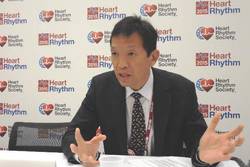 |
Dr. Fred M. Kusumoto |
MRI-safe implanted pacemakers have been routinely available in the United States for a few years, and since their U.S. introduction they have gradually increased their market share and have become the dominant device for younger patients and for patients with a scheduled, upcoming MRI.
Now that MRI-safe pacemakers and implantable cardioverter defibrillators exist, the next step will be to create an MRI-compatible cardiac resynchronization therapy device, but their more complicated design and lead placements will mean further design and engineering challenges.
Dr. Fred M. Kusumoto is a professor of medicine and an electrophysiologist at the Mayo Clinic in Jacksonville, Fla. He had no relevant financial disclosures. He made these comments in an interview.
MRI-safe implantable cardioverter defibrillators will become the standard of care. They are especially appropriate for patients who are younger when they receive their device and hence more likely to need an MRI at sometime in their future, as well as for older patients who are known to need an MRI in the foreseeable future.
 |
Dr. Fred M. Kusumoto |
MRI-safe implanted pacemakers have been routinely available in the United States for a few years, and since their U.S. introduction they have gradually increased their market share and have become the dominant device for younger patients and for patients with a scheduled, upcoming MRI.
Now that MRI-safe pacemakers and implantable cardioverter defibrillators exist, the next step will be to create an MRI-compatible cardiac resynchronization therapy device, but their more complicated design and lead placements will mean further design and engineering challenges.
Dr. Fred M. Kusumoto is a professor of medicine and an electrophysiologist at the Mayo Clinic in Jacksonville, Fla. He had no relevant financial disclosures. He made these comments in an interview.
MRI-safe implantable cardioverter defibrillators will become the standard of care. They are especially appropriate for patients who are younger when they receive their device and hence more likely to need an MRI at sometime in their future, as well as for older patients who are known to need an MRI in the foreseeable future.
 |
Dr. Fred M. Kusumoto |
MRI-safe implanted pacemakers have been routinely available in the United States for a few years, and since their U.S. introduction they have gradually increased their market share and have become the dominant device for younger patients and for patients with a scheduled, upcoming MRI.
Now that MRI-safe pacemakers and implantable cardioverter defibrillators exist, the next step will be to create an MRI-compatible cardiac resynchronization therapy device, but their more complicated design and lead placements will mean further design and engineering challenges.
Dr. Fred M. Kusumoto is a professor of medicine and an electrophysiologist at the Mayo Clinic in Jacksonville, Fla. He had no relevant financial disclosures. He made these comments in an interview.
BOSTON – An implantable cardioverter defibrillator device that can safely undergo magnetic resonance imaging may soon be a commercial reality as two different models from two different manufacturers showed safety and mostly uncompromised efficacy during and after MRI in two separate studies reported at the annual scientific sessions of the Heart Rhythm Society.
The impending availability of two different brands of implantable cardioverter defibrillators (ICDs) that allow patients to safely undergo MRI “will hopefully open a new era when most [ICDs] are designed” to be MRI safe, said Dr. Khaled A. Awad, an electrophysiologist at the University of Alabama at Birmingham, and lead investigator for one of the new studies.
“Within 10 years, all ICDs getting implanted will be MRI compatible,” predicted Dr. Michael R. Gold, chief of cardiology and medical director of the heart and vascular center at the Medical University of South Carolina in Charleston and lead investigator for the second study.
Until now, having an ICD in a patient created a contraindication for using MRI on the patient, a situation that would change once MRI-safe ICDs become routinely available, noted Dr. Gold. MRI-compatible implanted pacemakers have been on the U.S. market since 2011; ICDs able to safely undergo MRI exposure became the next frontier for creating implanted cardiovascular devices that allow MRIs. Both studies used MRI performed with a 1.5-T magnetic field, a strength commonly used in routine practice today.
The ProMRI study reported by Dr. Awad enrolled patients at 39 U.S. centers who at least 5 weeks previously had received an Iforia ICD made by Biotronik along with commercially available leads believed to be MRI safe. The researchers performed MRIs of the heart or thoracic spine on 154 patients, and then ran follow-up examinations on 150 patients 1 month after the MRI, and a second, 3-month follow-up on 92 of the enrolled patients. The study did not include any control patients who received the ICD and did not undergo MRI.
No patient had an adverse event related or possibly related to their ICD either at the time of the MRI or at follow-up, Dr. Awad reported. In addition, no patients had a significant change in their ICD’s ventricular capture threshold, and one patient had a significant change in the ICD’s ventricular sensing. During follow-up, the ICDs of enrolled patients detected a total of 403 ventricular arrhythmias in 39 patients, with all these episodes appropriately detected and treated.
The study reported by Dr. Gold enrolled patients at 42 centers in 13 countries including the United States. The investigators implanted ICDs into 263 patients using commercially available leads, and then 9-12 weeks after placement, they randomized patients at a 2:1 rate to either undergo MRI or receive no MRI and serve as controls. Of the 175 patients randomized to undergo MRI, 156 actually received the examination, a full-body examination, and 147 participated in follow-up to at least 1 month and were part of the safety analysis.
Patient follow-up showed no complications, no episodes of a significant change in ventricular-pacing sensing threshold, and one episode of a significant change in ventricular-sensing amplitude, Dr. Gold reported, showing safety and efficacy outcomes identical to those in the trial of the Biotronik device. During follow-up 34 episodes of ventricular tachycardia or fibrillation occurred in 24 patients in the MRI group, and the implanted ICDs detected and treated all episodes appropriately. Concurrent with Dr. Gold’s report, the results also appeared in an article published online (J. Am. Coll. Cardiol. 2015 [doi:10.1016/j.jacc.2015.04.047]).
mzoler@frontlinemedcom.com
On Twitter @mitchelzoler
BOSTON – An implantable cardioverter defibrillator device that can safely undergo magnetic resonance imaging may soon be a commercial reality as two different models from two different manufacturers showed safety and mostly uncompromised efficacy during and after MRI in two separate studies reported at the annual scientific sessions of the Heart Rhythm Society.
The impending availability of two different brands of implantable cardioverter defibrillators (ICDs) that allow patients to safely undergo MRI “will hopefully open a new era when most [ICDs] are designed” to be MRI safe, said Dr. Khaled A. Awad, an electrophysiologist at the University of Alabama at Birmingham, and lead investigator for one of the new studies.
“Within 10 years, all ICDs getting implanted will be MRI compatible,” predicted Dr. Michael R. Gold, chief of cardiology and medical director of the heart and vascular center at the Medical University of South Carolina in Charleston and lead investigator for the second study.
Until now, having an ICD in a patient created a contraindication for using MRI on the patient, a situation that would change once MRI-safe ICDs become routinely available, noted Dr. Gold. MRI-compatible implanted pacemakers have been on the U.S. market since 2011; ICDs able to safely undergo MRI exposure became the next frontier for creating implanted cardiovascular devices that allow MRIs. Both studies used MRI performed with a 1.5-T magnetic field, a strength commonly used in routine practice today.
The ProMRI study reported by Dr. Awad enrolled patients at 39 U.S. centers who at least 5 weeks previously had received an Iforia ICD made by Biotronik along with commercially available leads believed to be MRI safe. The researchers performed MRIs of the heart or thoracic spine on 154 patients, and then ran follow-up examinations on 150 patients 1 month after the MRI, and a second, 3-month follow-up on 92 of the enrolled patients. The study did not include any control patients who received the ICD and did not undergo MRI.
No patient had an adverse event related or possibly related to their ICD either at the time of the MRI or at follow-up, Dr. Awad reported. In addition, no patients had a significant change in their ICD’s ventricular capture threshold, and one patient had a significant change in the ICD’s ventricular sensing. During follow-up, the ICDs of enrolled patients detected a total of 403 ventricular arrhythmias in 39 patients, with all these episodes appropriately detected and treated.
The study reported by Dr. Gold enrolled patients at 42 centers in 13 countries including the United States. The investigators implanted ICDs into 263 patients using commercially available leads, and then 9-12 weeks after placement, they randomized patients at a 2:1 rate to either undergo MRI or receive no MRI and serve as controls. Of the 175 patients randomized to undergo MRI, 156 actually received the examination, a full-body examination, and 147 participated in follow-up to at least 1 month and were part of the safety analysis.
Patient follow-up showed no complications, no episodes of a significant change in ventricular-pacing sensing threshold, and one episode of a significant change in ventricular-sensing amplitude, Dr. Gold reported, showing safety and efficacy outcomes identical to those in the trial of the Biotronik device. During follow-up 34 episodes of ventricular tachycardia or fibrillation occurred in 24 patients in the MRI group, and the implanted ICDs detected and treated all episodes appropriately. Concurrent with Dr. Gold’s report, the results also appeared in an article published online (J. Am. Coll. Cardiol. 2015 [doi:10.1016/j.jacc.2015.04.047]).
mzoler@frontlinemedcom.com
On Twitter @mitchelzoler
AT HEART RHYTHM 2015
Key clinical point: Two different MRI-safe implantable cardioverter defibrillators showed safety and efficacy in pivotal trials.
Major finding: In each study, MRI produced no adverse events and resulted in one episode of impaired ventricular sensing.
Data source: A randomized, controlled trial with 253 patients and data from a prospective series of 154 patients.
Disclosures: Dr. Awad has received research support from Biosense Webster, and two of his coauthors are Biotronik employees. Dr. Gold has been a consultant to and received research grants from Boston Scientific, Medtronic, and St. Jude.
HRS: Riata lead problems still plague patients
BOSTON – The problem-plagued St. Jude Riata leads for implantable cardioverter defibrillators, pulled from the U.S. market in 2010, continue to pose problems for the tens of thousands of patients who still have them as clinicians follow these patients out to periods approaching 10 years.
But the risks of lead extraction continue make prophylactic lead removal a poor option for most patients, leaving the alternative of continuing to closely monitor patients for episodes of electrical lead failure, Dr. Ratika Parkash said at the annual scientific sessions of the Heart Rhythm Society.
“Isolated, prophylactic lead revision or extraction is not warranted,” said Dr. Parkash, a cardiac electrophysiologist at Dalhousie University in Halifax, Canada. “We need to take into account a patient’s comorbidities compared with the possibility of cable externalization,” when the conducting cable of the lead moves outside its insulating sheath, one of the main problems with the St. Jude Riata leads, she explained. “I think we need to individualize what we do” based on each patient’s specific situation, but perhaps collecting more data during another 2 years follow-up might shed more light on this issue, she said. Dr. Parkash and her associates followed Riata-lead recipients for an average of 7.5 years to produce the current report.
Although no U.S. patient has received a Riata lead for nearly 5 years, the Food and Drug Administration estimated that at the time St. Jude stopped selling this lead in late 2010 more than 227,000 Riata leads had gone into patients worldwide, including about 79,000 U.S. patients. Last February, St. Jude announced that it had settled 950 lawsuits or claims from U.S. patients who had received Riata leads.
The CREDO (Canadian Registry of Cardiac Implantable Electronic Device Outcomes) prospective registry review reported by Dr. Parkash included data from 2,707 patients who received Riata leads at any of 15 Canadian centers, representing 60% of the 4,538 Canadian residents who had received on of these leads. The patients averaged 63 years of age, 19% were women, 70% had received an 8 French lead and 30% had received a 7F lead, and follow-up data were available for an average of 7.5 years from the time patients received the leads to attach their implantable cardioverter defibrillator (ICD) to their heart.
During follow-up, 378 of the 2,707 patients (14%) required revision of their leads, a rate well above the rates seen collectively for all ICD lead models in data collected in both randomized trials and in the U.S. national registry of ICD implantations maintained by the National Cardiovascular Data Registry (OpenHeart 2015;2: [doi:10.1136/openhrt-2014-000198]). The rate of lead revisions seen with the Riata lead, 14% during 7.5 years follow-up, puts it in the ballpark of the 17% lead-failure rate with 5 year follow-up seen in Canadian patients who received a Sprint Fidelis lead that was marketed by Medtronic.(Circulation 2012:1217-25)
Triggering the 378 Riata revisions were electrical abnormalities, in 42%, lead dislodgement in 18%, cable externalization in 12%, infection in 12%, and several other types of events causing the other revisions.
The rate of electrical failures remained steady throughout follow-up, averaging about 0.8%/ year for both the 8F leads, which the researchers could follow for up to 10 years, and for the 7F leads, which they followed out to as long as 8 years. Cable externalizations occurred in 7% of the 8F leads and in 5% of the 7F leads, a difference that was not statistically significant. Fewer than half the patients, 1,187 (44%) underwent radiographic assessment of cable externalization. About 90% of all the detected cable externalizations in both the 7F and 8F leads did not produce electrical failure.
A multivariate analysis identified two factors independently linked with lead failure: patient age and left ventricular ejection fraction. Every 10 years of additional patient age linked with a 16% reduced rate of lead failure. And every 10% in additional ejection fraction linked with a 26% increased rate of lead failure.
The Canadian experience also documented the risk of undergoing lead revision, which happened for 253 patients and which led to 16 major complications, a 6% rate. Fifteen of the 16 major complications occurred without lead extraction taking place. Also, the major complications occurred at roughly similar rates in patients with 7F or 8F leads.
Dr. Parkash also highlighted that cable externalization often occurs late after implantation, and so additional cases are still possible. “We may just be seeing the cusp of lead failure” in the data collected so far, she suggested.
One concern the new data did not stoke is the risk for lead shorting that produces sudden ICD failure. “I think [shorting] is not as much of a problem as we previously thought,” Dr. Parkash said.
“These data give credence to the strategy of keeping the Riata leads in place, and, if you are concerned about their function, capping them and putting in a new lead,” commented Dr. Fred M. Kusumoto, an electrophysiologist and professor of medicine at the Mayo Clinic, Florida in Jacksonville. In addition, the new data demonstrate that the problem is in both the 7F as well as the 8F leads. “The entire Riata design was not very good,” he said in an interview. But a reassuring result in the Canadian registry was the low rate of shorting, or high-voltage failure of the lead, Dr. Kusumoto said.
On Twitter @mitchelzoler
We need to know what happens to the Riata lead over time, so these are very important findings. The continuous increase in adverse lead events over time is concerning. It raises the question of what is the best strategy for monitoring patients who have a Riata lead. Is there something else we should be doing to better identify patients who are having a lead problem?
 |
| Mitchel L. Zoler/Frontline Medical News Dr. Andrea M. Russo |
For example, some electrophysiologists propose testing the ongoing function of Riata leads with a high-voltage test. We don’t yet know if this test would benefit patients, but these data give us better perspective on the risks these patients face.
The cable externalization seen with the Riata lead is an unusual type of lead failure that is different from what we see with most leads for implantable cardioverter defibrillators. In addition, no data exist to support routine extraction of these leads. The Food and Drug Administration has recommended “close monitoring” and regular imaging of the leads, but beyond that different centers handle follow-up in different ways.
We need a better way to screen for electrical failure because x-ray imaging alone does not seem effective enough. It will be interesting to see the results after the Canadian researchers do a more detailed analysis of their data to provide further insight into effective methods for screening patients with Riata leads.
Dr. Andrea M. Russo is professor and director of the electrophysiology and arrhythmia service at Cooper University Hospital in Camden, N.J. She made these comments in an interview. Dr. Russo has been a consultant to St. Jude, Biotronik, Boston Scientific and Medtronic.
We need to know what happens to the Riata lead over time, so these are very important findings. The continuous increase in adverse lead events over time is concerning. It raises the question of what is the best strategy for monitoring patients who have a Riata lead. Is there something else we should be doing to better identify patients who are having a lead problem?
 |
| Mitchel L. Zoler/Frontline Medical News Dr. Andrea M. Russo |
For example, some electrophysiologists propose testing the ongoing function of Riata leads with a high-voltage test. We don’t yet know if this test would benefit patients, but these data give us better perspective on the risks these patients face.
The cable externalization seen with the Riata lead is an unusual type of lead failure that is different from what we see with most leads for implantable cardioverter defibrillators. In addition, no data exist to support routine extraction of these leads. The Food and Drug Administration has recommended “close monitoring” and regular imaging of the leads, but beyond that different centers handle follow-up in different ways.
We need a better way to screen for electrical failure because x-ray imaging alone does not seem effective enough. It will be interesting to see the results after the Canadian researchers do a more detailed analysis of their data to provide further insight into effective methods for screening patients with Riata leads.
Dr. Andrea M. Russo is professor and director of the electrophysiology and arrhythmia service at Cooper University Hospital in Camden, N.J. She made these comments in an interview. Dr. Russo has been a consultant to St. Jude, Biotronik, Boston Scientific and Medtronic.
We need to know what happens to the Riata lead over time, so these are very important findings. The continuous increase in adverse lead events over time is concerning. It raises the question of what is the best strategy for monitoring patients who have a Riata lead. Is there something else we should be doing to better identify patients who are having a lead problem?
 |
| Mitchel L. Zoler/Frontline Medical News Dr. Andrea M. Russo |
For example, some electrophysiologists propose testing the ongoing function of Riata leads with a high-voltage test. We don’t yet know if this test would benefit patients, but these data give us better perspective on the risks these patients face.
The cable externalization seen with the Riata lead is an unusual type of lead failure that is different from what we see with most leads for implantable cardioverter defibrillators. In addition, no data exist to support routine extraction of these leads. The Food and Drug Administration has recommended “close monitoring” and regular imaging of the leads, but beyond that different centers handle follow-up in different ways.
We need a better way to screen for electrical failure because x-ray imaging alone does not seem effective enough. It will be interesting to see the results after the Canadian researchers do a more detailed analysis of their data to provide further insight into effective methods for screening patients with Riata leads.
Dr. Andrea M. Russo is professor and director of the electrophysiology and arrhythmia service at Cooper University Hospital in Camden, N.J. She made these comments in an interview. Dr. Russo has been a consultant to St. Jude, Biotronik, Boston Scientific and Medtronic.
BOSTON – The problem-plagued St. Jude Riata leads for implantable cardioverter defibrillators, pulled from the U.S. market in 2010, continue to pose problems for the tens of thousands of patients who still have them as clinicians follow these patients out to periods approaching 10 years.
But the risks of lead extraction continue make prophylactic lead removal a poor option for most patients, leaving the alternative of continuing to closely monitor patients for episodes of electrical lead failure, Dr. Ratika Parkash said at the annual scientific sessions of the Heart Rhythm Society.
“Isolated, prophylactic lead revision or extraction is not warranted,” said Dr. Parkash, a cardiac electrophysiologist at Dalhousie University in Halifax, Canada. “We need to take into account a patient’s comorbidities compared with the possibility of cable externalization,” when the conducting cable of the lead moves outside its insulating sheath, one of the main problems with the St. Jude Riata leads, she explained. “I think we need to individualize what we do” based on each patient’s specific situation, but perhaps collecting more data during another 2 years follow-up might shed more light on this issue, she said. Dr. Parkash and her associates followed Riata-lead recipients for an average of 7.5 years to produce the current report.
Although no U.S. patient has received a Riata lead for nearly 5 years, the Food and Drug Administration estimated that at the time St. Jude stopped selling this lead in late 2010 more than 227,000 Riata leads had gone into patients worldwide, including about 79,000 U.S. patients. Last February, St. Jude announced that it had settled 950 lawsuits or claims from U.S. patients who had received Riata leads.
The CREDO (Canadian Registry of Cardiac Implantable Electronic Device Outcomes) prospective registry review reported by Dr. Parkash included data from 2,707 patients who received Riata leads at any of 15 Canadian centers, representing 60% of the 4,538 Canadian residents who had received on of these leads. The patients averaged 63 years of age, 19% were women, 70% had received an 8 French lead and 30% had received a 7F lead, and follow-up data were available for an average of 7.5 years from the time patients received the leads to attach their implantable cardioverter defibrillator (ICD) to their heart.
During follow-up, 378 of the 2,707 patients (14%) required revision of their leads, a rate well above the rates seen collectively for all ICD lead models in data collected in both randomized trials and in the U.S. national registry of ICD implantations maintained by the National Cardiovascular Data Registry (OpenHeart 2015;2: [doi:10.1136/openhrt-2014-000198]). The rate of lead revisions seen with the Riata lead, 14% during 7.5 years follow-up, puts it in the ballpark of the 17% lead-failure rate with 5 year follow-up seen in Canadian patients who received a Sprint Fidelis lead that was marketed by Medtronic.(Circulation 2012:1217-25)
Triggering the 378 Riata revisions were electrical abnormalities, in 42%, lead dislodgement in 18%, cable externalization in 12%, infection in 12%, and several other types of events causing the other revisions.
The rate of electrical failures remained steady throughout follow-up, averaging about 0.8%/ year for both the 8F leads, which the researchers could follow for up to 10 years, and for the 7F leads, which they followed out to as long as 8 years. Cable externalizations occurred in 7% of the 8F leads and in 5% of the 7F leads, a difference that was not statistically significant. Fewer than half the patients, 1,187 (44%) underwent radiographic assessment of cable externalization. About 90% of all the detected cable externalizations in both the 7F and 8F leads did not produce electrical failure.
A multivariate analysis identified two factors independently linked with lead failure: patient age and left ventricular ejection fraction. Every 10 years of additional patient age linked with a 16% reduced rate of lead failure. And every 10% in additional ejection fraction linked with a 26% increased rate of lead failure.
The Canadian experience also documented the risk of undergoing lead revision, which happened for 253 patients and which led to 16 major complications, a 6% rate. Fifteen of the 16 major complications occurred without lead extraction taking place. Also, the major complications occurred at roughly similar rates in patients with 7F or 8F leads.
Dr. Parkash also highlighted that cable externalization often occurs late after implantation, and so additional cases are still possible. “We may just be seeing the cusp of lead failure” in the data collected so far, she suggested.
One concern the new data did not stoke is the risk for lead shorting that produces sudden ICD failure. “I think [shorting] is not as much of a problem as we previously thought,” Dr. Parkash said.
“These data give credence to the strategy of keeping the Riata leads in place, and, if you are concerned about their function, capping them and putting in a new lead,” commented Dr. Fred M. Kusumoto, an electrophysiologist and professor of medicine at the Mayo Clinic, Florida in Jacksonville. In addition, the new data demonstrate that the problem is in both the 7F as well as the 8F leads. “The entire Riata design was not very good,” he said in an interview. But a reassuring result in the Canadian registry was the low rate of shorting, or high-voltage failure of the lead, Dr. Kusumoto said.
On Twitter @mitchelzoler
BOSTON – The problem-plagued St. Jude Riata leads for implantable cardioverter defibrillators, pulled from the U.S. market in 2010, continue to pose problems for the tens of thousands of patients who still have them as clinicians follow these patients out to periods approaching 10 years.
But the risks of lead extraction continue make prophylactic lead removal a poor option for most patients, leaving the alternative of continuing to closely monitor patients for episodes of electrical lead failure, Dr. Ratika Parkash said at the annual scientific sessions of the Heart Rhythm Society.
“Isolated, prophylactic lead revision or extraction is not warranted,” said Dr. Parkash, a cardiac electrophysiologist at Dalhousie University in Halifax, Canada. “We need to take into account a patient’s comorbidities compared with the possibility of cable externalization,” when the conducting cable of the lead moves outside its insulating sheath, one of the main problems with the St. Jude Riata leads, she explained. “I think we need to individualize what we do” based on each patient’s specific situation, but perhaps collecting more data during another 2 years follow-up might shed more light on this issue, she said. Dr. Parkash and her associates followed Riata-lead recipients for an average of 7.5 years to produce the current report.
Although no U.S. patient has received a Riata lead for nearly 5 years, the Food and Drug Administration estimated that at the time St. Jude stopped selling this lead in late 2010 more than 227,000 Riata leads had gone into patients worldwide, including about 79,000 U.S. patients. Last February, St. Jude announced that it had settled 950 lawsuits or claims from U.S. patients who had received Riata leads.
The CREDO (Canadian Registry of Cardiac Implantable Electronic Device Outcomes) prospective registry review reported by Dr. Parkash included data from 2,707 patients who received Riata leads at any of 15 Canadian centers, representing 60% of the 4,538 Canadian residents who had received on of these leads. The patients averaged 63 years of age, 19% were women, 70% had received an 8 French lead and 30% had received a 7F lead, and follow-up data were available for an average of 7.5 years from the time patients received the leads to attach their implantable cardioverter defibrillator (ICD) to their heart.
During follow-up, 378 of the 2,707 patients (14%) required revision of their leads, a rate well above the rates seen collectively for all ICD lead models in data collected in both randomized trials and in the U.S. national registry of ICD implantations maintained by the National Cardiovascular Data Registry (OpenHeart 2015;2: [doi:10.1136/openhrt-2014-000198]). The rate of lead revisions seen with the Riata lead, 14% during 7.5 years follow-up, puts it in the ballpark of the 17% lead-failure rate with 5 year follow-up seen in Canadian patients who received a Sprint Fidelis lead that was marketed by Medtronic.(Circulation 2012:1217-25)
Triggering the 378 Riata revisions were electrical abnormalities, in 42%, lead dislodgement in 18%, cable externalization in 12%, infection in 12%, and several other types of events causing the other revisions.
The rate of electrical failures remained steady throughout follow-up, averaging about 0.8%/ year for both the 8F leads, which the researchers could follow for up to 10 years, and for the 7F leads, which they followed out to as long as 8 years. Cable externalizations occurred in 7% of the 8F leads and in 5% of the 7F leads, a difference that was not statistically significant. Fewer than half the patients, 1,187 (44%) underwent radiographic assessment of cable externalization. About 90% of all the detected cable externalizations in both the 7F and 8F leads did not produce electrical failure.
A multivariate analysis identified two factors independently linked with lead failure: patient age and left ventricular ejection fraction. Every 10 years of additional patient age linked with a 16% reduced rate of lead failure. And every 10% in additional ejection fraction linked with a 26% increased rate of lead failure.
The Canadian experience also documented the risk of undergoing lead revision, which happened for 253 patients and which led to 16 major complications, a 6% rate. Fifteen of the 16 major complications occurred without lead extraction taking place. Also, the major complications occurred at roughly similar rates in patients with 7F or 8F leads.
Dr. Parkash also highlighted that cable externalization often occurs late after implantation, and so additional cases are still possible. “We may just be seeing the cusp of lead failure” in the data collected so far, she suggested.
One concern the new data did not stoke is the risk for lead shorting that produces sudden ICD failure. “I think [shorting] is not as much of a problem as we previously thought,” Dr. Parkash said.
“These data give credence to the strategy of keeping the Riata leads in place, and, if you are concerned about their function, capping them and putting in a new lead,” commented Dr. Fred M. Kusumoto, an electrophysiologist and professor of medicine at the Mayo Clinic, Florida in Jacksonville. In addition, the new data demonstrate that the problem is in both the 7F as well as the 8F leads. “The entire Riata design was not very good,” he said in an interview. But a reassuring result in the Canadian registry was the low rate of shorting, or high-voltage failure of the lead, Dr. Kusumoto said.
On Twitter @mitchelzoler
AT HEART RHYTHM 2015
Key clinical point: During an average 7.5 years of follow-up Riata leads for implantable cardioverter defibrillators showed about a 0.8%/year failure rate.
Major finding: The Riata ICD leads showed a roughly 6% electrical failure rate and 7% total failure rate with 10-year follow-up.
Data source: CREDO, a prospective registry of ICD recipients at 15 Canadian centers which enrolled 2,707 patients who received Riata leads.
Disclosures: Dr. Parkash has been a consultant to St. Jude, Pfizer, and Bayer, and has received research funding from Schering-Plough and Medtronic. Dr. Kusumoto had no relevant disclosures.
HRS: Linear ablation adds nothing to atrial fib PVI
BOSTON – Adding extra ablation lines on top of pulmonary vein isolation treatment of persistent atrial fibrillation failed to improve patient outcomes but prolonged treatment and exposed patients to significantly more fluoroscopy and radiation in results from a multicenter, randomized trial with 124 patients.
“In patients with presumed substrate-based AF, adding linear ablation lesions to wide area circumferential ablation of the pulmonary vein provides no additional clinical benefit,” and carries the downside of longer procedures with increased fluoroscopy and radiation exposure, Dr. Gareth J. Wynn said at the annual scientific sessions of the Heart Rhythm Society.
“A few years ago, people were saying you need additional ablation lines, but these results and prior reports suggest that just pulmonary vein isolation [PVI] is sufficient,” commented Dr. Fred M. Kusumoto, an electrophysiologist and professor at Mayo Clinic, Florida in Jacksonville.
The study run by Dr. Wynn and his associates at three U.K. centers randomized 122 intention-to-treat patients considered to have a high likelihood of substrate-based AF, defined as either persistent AF of less than 1 year’s duration or sustained AF episodes plus at least one comorbidity that increases persistent AF risk. The study excluded patients who had previously undergone ablation as well as those with persistent AF beyond 1 year. The patients’ average age was 62 years; two-thirds were men, and 61% had persistent AF.
All patients underwent PVI by wide-area circumferential ablation, and those randomized to the added-treatment group also received ablation along the left atrial root, the mitral isthmus, and the cavotricuspid isthmus. The ablation procedures used “modern technology,” Dr. Wynn said, including three-dimensional electroanatomic mapping and contact-force sensing catheters. Bidirectional block in all three attempted lines occurred in 81% of patients randomized to that treatment. All patients received an antiarrhythmic drug, either flecainide or amiodarone for about 6 weeks before and for 6 weeks after ablation.
Patients in the PVI plus linear ablation group had procedures that took an average of 37 minutes longer, a 22% increase in time compared with PVI only. Patients who received linear ablations also had a nearly 50% average increase in their fluoroscopy time, and their average radiation exposure nearly doubled the amount used on the PVI-only patients.
Despite the longer, more involved procedures, patients who received the extra ablations had about as many recurrent AF or atrial tachycardia cases as patients treated with PVI only, reported Dr. Wynn, an electrophysiologist at the Liverpool (U.K.) Heart and Chest Hospital. After 1 year of follow-up, recurrent events occurred in 32% of those who received PVI only and in 38% of those who also received linear ablations, the study’s primary endpoint. Patients who received the linear ablations also showed no improvement in their quality of life assessments of both mental and physical status compared with the PVI-only patients.
On Twitter @mitchelzoler
Controversy has existed for years over whether one should add some linear lesions when performing pulmonary vein isolation for atrial fibrillation, especially in patients with more persistent AF. Adding linear ablations takes more time and perhaps puts patients at additional risk with more fluoroscopy and radiation. The results from Dr. Wynn’s study showed that adding the extra ablation lines did not improve outcomes, and this confirms similar findings previously reported from other studies.
 |
| Mitchel L. Zoler/Frontline Medical News Dr. Andrea M. Russo |
I believe that all these data collectively will have a significant impact on future ablation treatment for atrial fibrillation. Everyone agrees about performing pulmonary vein isolation. These new results will help make electrophysiologists more selective about also using linear ablations. There is certainly no need to perform them in all patients. We need to figure out when it is better to add something to PVI, and when PVI alone is sufficient.
Dr. Andrea M. Russo is professor and director of the electrophysiology and arrhythmia service at Cooper University Hospital in Camden, N.J. She made these comments in an interview. Dr. Russo has been a consultant to St. Jude, Biotronik, Boston Scientific and Medtronic.
Controversy has existed for years over whether one should add some linear lesions when performing pulmonary vein isolation for atrial fibrillation, especially in patients with more persistent AF. Adding linear ablations takes more time and perhaps puts patients at additional risk with more fluoroscopy and radiation. The results from Dr. Wynn’s study showed that adding the extra ablation lines did not improve outcomes, and this confirms similar findings previously reported from other studies.
 |
| Mitchel L. Zoler/Frontline Medical News Dr. Andrea M. Russo |
I believe that all these data collectively will have a significant impact on future ablation treatment for atrial fibrillation. Everyone agrees about performing pulmonary vein isolation. These new results will help make electrophysiologists more selective about also using linear ablations. There is certainly no need to perform them in all patients. We need to figure out when it is better to add something to PVI, and when PVI alone is sufficient.
Dr. Andrea M. Russo is professor and director of the electrophysiology and arrhythmia service at Cooper University Hospital in Camden, N.J. She made these comments in an interview. Dr. Russo has been a consultant to St. Jude, Biotronik, Boston Scientific and Medtronic.
Controversy has existed for years over whether one should add some linear lesions when performing pulmonary vein isolation for atrial fibrillation, especially in patients with more persistent AF. Adding linear ablations takes more time and perhaps puts patients at additional risk with more fluoroscopy and radiation. The results from Dr. Wynn’s study showed that adding the extra ablation lines did not improve outcomes, and this confirms similar findings previously reported from other studies.
 |
| Mitchel L. Zoler/Frontline Medical News Dr. Andrea M. Russo |
I believe that all these data collectively will have a significant impact on future ablation treatment for atrial fibrillation. Everyone agrees about performing pulmonary vein isolation. These new results will help make electrophysiologists more selective about also using linear ablations. There is certainly no need to perform them in all patients. We need to figure out when it is better to add something to PVI, and when PVI alone is sufficient.
Dr. Andrea M. Russo is professor and director of the electrophysiology and arrhythmia service at Cooper University Hospital in Camden, N.J. She made these comments in an interview. Dr. Russo has been a consultant to St. Jude, Biotronik, Boston Scientific and Medtronic.
BOSTON – Adding extra ablation lines on top of pulmonary vein isolation treatment of persistent atrial fibrillation failed to improve patient outcomes but prolonged treatment and exposed patients to significantly more fluoroscopy and radiation in results from a multicenter, randomized trial with 124 patients.
“In patients with presumed substrate-based AF, adding linear ablation lesions to wide area circumferential ablation of the pulmonary vein provides no additional clinical benefit,” and carries the downside of longer procedures with increased fluoroscopy and radiation exposure, Dr. Gareth J. Wynn said at the annual scientific sessions of the Heart Rhythm Society.
“A few years ago, people were saying you need additional ablation lines, but these results and prior reports suggest that just pulmonary vein isolation [PVI] is sufficient,” commented Dr. Fred M. Kusumoto, an electrophysiologist and professor at Mayo Clinic, Florida in Jacksonville.
The study run by Dr. Wynn and his associates at three U.K. centers randomized 122 intention-to-treat patients considered to have a high likelihood of substrate-based AF, defined as either persistent AF of less than 1 year’s duration or sustained AF episodes plus at least one comorbidity that increases persistent AF risk. The study excluded patients who had previously undergone ablation as well as those with persistent AF beyond 1 year. The patients’ average age was 62 years; two-thirds were men, and 61% had persistent AF.
All patients underwent PVI by wide-area circumferential ablation, and those randomized to the added-treatment group also received ablation along the left atrial root, the mitral isthmus, and the cavotricuspid isthmus. The ablation procedures used “modern technology,” Dr. Wynn said, including three-dimensional electroanatomic mapping and contact-force sensing catheters. Bidirectional block in all three attempted lines occurred in 81% of patients randomized to that treatment. All patients received an antiarrhythmic drug, either flecainide or amiodarone for about 6 weeks before and for 6 weeks after ablation.
Patients in the PVI plus linear ablation group had procedures that took an average of 37 minutes longer, a 22% increase in time compared with PVI only. Patients who received linear ablations also had a nearly 50% average increase in their fluoroscopy time, and their average radiation exposure nearly doubled the amount used on the PVI-only patients.
Despite the longer, more involved procedures, patients who received the extra ablations had about as many recurrent AF or atrial tachycardia cases as patients treated with PVI only, reported Dr. Wynn, an electrophysiologist at the Liverpool (U.K.) Heart and Chest Hospital. After 1 year of follow-up, recurrent events occurred in 32% of those who received PVI only and in 38% of those who also received linear ablations, the study’s primary endpoint. Patients who received the linear ablations also showed no improvement in their quality of life assessments of both mental and physical status compared with the PVI-only patients.
On Twitter @mitchelzoler
BOSTON – Adding extra ablation lines on top of pulmonary vein isolation treatment of persistent atrial fibrillation failed to improve patient outcomes but prolonged treatment and exposed patients to significantly more fluoroscopy and radiation in results from a multicenter, randomized trial with 124 patients.
“In patients with presumed substrate-based AF, adding linear ablation lesions to wide area circumferential ablation of the pulmonary vein provides no additional clinical benefit,” and carries the downside of longer procedures with increased fluoroscopy and radiation exposure, Dr. Gareth J. Wynn said at the annual scientific sessions of the Heart Rhythm Society.
“A few years ago, people were saying you need additional ablation lines, but these results and prior reports suggest that just pulmonary vein isolation [PVI] is sufficient,” commented Dr. Fred M. Kusumoto, an electrophysiologist and professor at Mayo Clinic, Florida in Jacksonville.
The study run by Dr. Wynn and his associates at three U.K. centers randomized 122 intention-to-treat patients considered to have a high likelihood of substrate-based AF, defined as either persistent AF of less than 1 year’s duration or sustained AF episodes plus at least one comorbidity that increases persistent AF risk. The study excluded patients who had previously undergone ablation as well as those with persistent AF beyond 1 year. The patients’ average age was 62 years; two-thirds were men, and 61% had persistent AF.
All patients underwent PVI by wide-area circumferential ablation, and those randomized to the added-treatment group also received ablation along the left atrial root, the mitral isthmus, and the cavotricuspid isthmus. The ablation procedures used “modern technology,” Dr. Wynn said, including three-dimensional electroanatomic mapping and contact-force sensing catheters. Bidirectional block in all three attempted lines occurred in 81% of patients randomized to that treatment. All patients received an antiarrhythmic drug, either flecainide or amiodarone for about 6 weeks before and for 6 weeks after ablation.
Patients in the PVI plus linear ablation group had procedures that took an average of 37 minutes longer, a 22% increase in time compared with PVI only. Patients who received linear ablations also had a nearly 50% average increase in their fluoroscopy time, and their average radiation exposure nearly doubled the amount used on the PVI-only patients.
Despite the longer, more involved procedures, patients who received the extra ablations had about as many recurrent AF or atrial tachycardia cases as patients treated with PVI only, reported Dr. Wynn, an electrophysiologist at the Liverpool (U.K.) Heart and Chest Hospital. After 1 year of follow-up, recurrent events occurred in 32% of those who received PVI only and in 38% of those who also received linear ablations, the study’s primary endpoint. Patients who received the linear ablations also showed no improvement in their quality of life assessments of both mental and physical status compared with the PVI-only patients.
On Twitter @mitchelzoler
AT HEART RHYTHM 2015
Key clinical point:Linear ablation lines provided no added benefit to patients with persistent atrial fibrillation who underwent atrial ablation to produced pulmonary vein isolation.
Major finding: After 1 year, recurrent AF occurred in 32% treated with PVI and 38% treated with PVI plus linear ablations.
Data source: Randomized trial of 122 patients with persistent AF for less than 1 year at three U.K. centers.
Disclosures: Dr. Wynn and Dr. Kusumoto had no disclosures.
HRS: Cardiac device remote monitoring drops hospitalizations, costs
BOSTON – Remote monitoring of implanted cardiac devices, already known to save lives, also reduced all-cause hospitalizations and cut hospitalization costs substantially in a review of more than 92,000 U.S. patients followed for 5 years.
The analysis showed that for every 100,000 patient-years of remote monitoring of implanted pacemakers, implantable cardioverter defibrillators (ICDs), and cardiac resynchronization therapy (CRT) devices, there were 9,810 fewer all-cause hospitalizations, 119,000 fewer days spent hospitalized, and a savings of more than $370 million, compared with similar patients who did not undergo remote monitoring, Dr. Jonathan P. Piccini, Sr. said at the annual scientific sessions of the Heart Rhythm Society.
While these results are perhaps the first to document the impact of remote monitoring of implanted cardiac devices on health care use and cost, several previously reported study findings showed the positive impact of remote monitoring on clinical outcomes. For example, the IN-TIME (Influence of Home Monitoring on the Clinical Status of Heart Failure Patients With an Impaired Left Ventricular Function) trial randomized 664 patients with either ICDs or CRT devices to remote monitoring plus clinic visits or to monitoring by clinic visits only. After 1 year, patients on remote monitoring had a statistically significant 37% reduction in bad clinical outcomes, compared with the control patients (Lancet 2014;384:583-90). And findings from an observational study recently published by Dr. Piccini and his associates that involved 269,471 Americans with cardiac devices showed that 47% used remote monitoring, and the survival rate among users ran double that of patients with devices who did not undergo remote monitoring (J. Am. Coll. Cardiol. 2015 [doi:10.1016/j.jacc.2015.04.033]).
Despite this evidence for a substantial clinical benefit, remote monitoring has not become routine for U.S. patients with a pacemaker, ICD, or CRT device. During the period April 2008–March 2013 studied by Dr. Piccini and his associates using a health insurance claims database representative of the U.S. adult population, of 92,566 patients with an implanted device, 34,259 (37%) underwent remote monitoring.
“Remote monitoring has been underutilized,” commented Dr. Michael R. Gold, chief of cardiology and medical director of the Heart and Vascular Center at the Medical University of South Carolina in Charleston. One reason that patients don’t undergo remote monitoring today is that many remote monitoring systems require a land line telephone for data collection and transmittal, while many patients now just have a mobile phone, Dr. Gold said. Mobile phone adapters are available but the patient must buy one.
Remote monitoring can dramatically reduce the need for office visits by patients, Dr. Gold said. “Without remote monitoring we see patients with devices every 3 months; with remote monitoring I usually see then once a year,” he said.
Remote monitoring may now start increasing, driven by the compelling evidence of efficacy and cost saving and also by the statement released in mid-May by the an expert consensus panel of the Heart Rhythm Society that remote monitoring ”represents the new standard of care” for patients with cardiovascular implantable electronic devices (Heart Rhythm 2015 [doi.10.1016/j.hrthm.2015.05.008]).
To run their hospitalization analysis, Dr. Piccini and his associates retrospectively reviewed data from 92,566 U.S. patients with an implanted pacemaker, ICD, or CRT device during April 2008–March 2013 collected in the MarketScan database, which includes patients covered by private insurance or Medicare. During the period studied 58,307 (63%) patients were followed by clinic visits only while the others received both clinic visits and remote monitoring.
Most of the patients, 59%, carried a pacemaker, and 29% of the patients in this device subgroup had remote monitoring. In contrast, about half of the other patients had remote monitoring, both the 30% of patients who had an ICD, as well as the 11% with a CRT device.
The rate of all-cause hospitalization during follow-up, the analysis’s primary outcome, was 18% lower in the remote-monitoring patients, a statistically significant difference. In addition, when hospitalized the average hospital length of stay ran a third lower in the remotely monitored patients, a reduction of nearly 3 days in the hospital for each hospitalized patient and a cost savings of about 30% or $3,703 per hospitalized patient. Device type did not seem to matter, Dr. Piccini reported.
The analysis dug further to focus on rates for two common causes of hospitalization in device patients, and found a statistically significant 24% reduction in hospitalization for heart failure, and a significant 22% drop in the rate of stroke hospitalization. Remote monitoring can reduce heart failure hospitalizations in many ways, by keeping tabs on heart rate, arrhythmias, overall activity level, and chest-cavity fluid level measured by changes in myocardial impedance.
The study findings highlight “a major opportunity for quality improvement,” Dr. Piccini concluded. “There is plenty of evidence to motivate physicians, health care systems, and payers” to embrace the new HRS recommendations on remote monitoring. But to be effective, each patient participating in remote monitoring must be educated about the process and be willing to take the steps necessary to make remote monitoring succeed, he added.
On Twitter @mitchelzoler
Data like those in Dr. Piccini’s report as well as the statement in May from the Heart Rhythm Society calling remote monitoring the standard of care (Heart Rhythm 2015 [doi.10.1016/j.hrthm.2015.05.008]) are very compelling. There has been a lag in the uptake of remote monitoring, but these new developments will make it impossible for administrators and payers to ignore remote monitoring any longer.
Document
|
| Mitchel L. Zoler/Frontline Medical News Dr. Jonathan M. Kalman |
What we need now is an infrastructure to provide remote monitoring to the millions of patients who have implanted cardiovascular devices. Adopting remote monitoring as the standard of care involves more than just a declaration. Monitoring programs need capable technicians who can collect and evaluate the data that come in. It’s a big commitment, but something for which the benefit clearly outweighs the cost. We keep patients in better health while seeing them less often.
Dr. Jonathan M. Kalman is professor and head of the heart rhythm department of Royal Melbourne Hospital, Australia. He has received research support from Boston Scientific, Medtronic, and St. Jude. He made these comments in an interview.
Data like those in Dr. Piccini’s report as well as the statement in May from the Heart Rhythm Society calling remote monitoring the standard of care (Heart Rhythm 2015 [doi.10.1016/j.hrthm.2015.05.008]) are very compelling. There has been a lag in the uptake of remote monitoring, but these new developments will make it impossible for administrators and payers to ignore remote monitoring any longer.
Document
|
| Mitchel L. Zoler/Frontline Medical News Dr. Jonathan M. Kalman |
What we need now is an infrastructure to provide remote monitoring to the millions of patients who have implanted cardiovascular devices. Adopting remote monitoring as the standard of care involves more than just a declaration. Monitoring programs need capable technicians who can collect and evaluate the data that come in. It’s a big commitment, but something for which the benefit clearly outweighs the cost. We keep patients in better health while seeing them less often.
Dr. Jonathan M. Kalman is professor and head of the heart rhythm department of Royal Melbourne Hospital, Australia. He has received research support from Boston Scientific, Medtronic, and St. Jude. He made these comments in an interview.
Data like those in Dr. Piccini’s report as well as the statement in May from the Heart Rhythm Society calling remote monitoring the standard of care (Heart Rhythm 2015 [doi.10.1016/j.hrthm.2015.05.008]) are very compelling. There has been a lag in the uptake of remote monitoring, but these new developments will make it impossible for administrators and payers to ignore remote monitoring any longer.
Document
|
| Mitchel L. Zoler/Frontline Medical News Dr. Jonathan M. Kalman |
What we need now is an infrastructure to provide remote monitoring to the millions of patients who have implanted cardiovascular devices. Adopting remote monitoring as the standard of care involves more than just a declaration. Monitoring programs need capable technicians who can collect and evaluate the data that come in. It’s a big commitment, but something for which the benefit clearly outweighs the cost. We keep patients in better health while seeing them less often.
Dr. Jonathan M. Kalman is professor and head of the heart rhythm department of Royal Melbourne Hospital, Australia. He has received research support from Boston Scientific, Medtronic, and St. Jude. He made these comments in an interview.
BOSTON – Remote monitoring of implanted cardiac devices, already known to save lives, also reduced all-cause hospitalizations and cut hospitalization costs substantially in a review of more than 92,000 U.S. patients followed for 5 years.
The analysis showed that for every 100,000 patient-years of remote monitoring of implanted pacemakers, implantable cardioverter defibrillators (ICDs), and cardiac resynchronization therapy (CRT) devices, there were 9,810 fewer all-cause hospitalizations, 119,000 fewer days spent hospitalized, and a savings of more than $370 million, compared with similar patients who did not undergo remote monitoring, Dr. Jonathan P. Piccini, Sr. said at the annual scientific sessions of the Heart Rhythm Society.
While these results are perhaps the first to document the impact of remote monitoring of implanted cardiac devices on health care use and cost, several previously reported study findings showed the positive impact of remote monitoring on clinical outcomes. For example, the IN-TIME (Influence of Home Monitoring on the Clinical Status of Heart Failure Patients With an Impaired Left Ventricular Function) trial randomized 664 patients with either ICDs or CRT devices to remote monitoring plus clinic visits or to monitoring by clinic visits only. After 1 year, patients on remote monitoring had a statistically significant 37% reduction in bad clinical outcomes, compared with the control patients (Lancet 2014;384:583-90). And findings from an observational study recently published by Dr. Piccini and his associates that involved 269,471 Americans with cardiac devices showed that 47% used remote monitoring, and the survival rate among users ran double that of patients with devices who did not undergo remote monitoring (J. Am. Coll. Cardiol. 2015 [doi:10.1016/j.jacc.2015.04.033]).
Despite this evidence for a substantial clinical benefit, remote monitoring has not become routine for U.S. patients with a pacemaker, ICD, or CRT device. During the period April 2008–March 2013 studied by Dr. Piccini and his associates using a health insurance claims database representative of the U.S. adult population, of 92,566 patients with an implanted device, 34,259 (37%) underwent remote monitoring.
“Remote monitoring has been underutilized,” commented Dr. Michael R. Gold, chief of cardiology and medical director of the Heart and Vascular Center at the Medical University of South Carolina in Charleston. One reason that patients don’t undergo remote monitoring today is that many remote monitoring systems require a land line telephone for data collection and transmittal, while many patients now just have a mobile phone, Dr. Gold said. Mobile phone adapters are available but the patient must buy one.
Remote monitoring can dramatically reduce the need for office visits by patients, Dr. Gold said. “Without remote monitoring we see patients with devices every 3 months; with remote monitoring I usually see then once a year,” he said.
Remote monitoring may now start increasing, driven by the compelling evidence of efficacy and cost saving and also by the statement released in mid-May by the an expert consensus panel of the Heart Rhythm Society that remote monitoring ”represents the new standard of care” for patients with cardiovascular implantable electronic devices (Heart Rhythm 2015 [doi.10.1016/j.hrthm.2015.05.008]).
To run their hospitalization analysis, Dr. Piccini and his associates retrospectively reviewed data from 92,566 U.S. patients with an implanted pacemaker, ICD, or CRT device during April 2008–March 2013 collected in the MarketScan database, which includes patients covered by private insurance or Medicare. During the period studied 58,307 (63%) patients were followed by clinic visits only while the others received both clinic visits and remote monitoring.
Most of the patients, 59%, carried a pacemaker, and 29% of the patients in this device subgroup had remote monitoring. In contrast, about half of the other patients had remote monitoring, both the 30% of patients who had an ICD, as well as the 11% with a CRT device.
The rate of all-cause hospitalization during follow-up, the analysis’s primary outcome, was 18% lower in the remote-monitoring patients, a statistically significant difference. In addition, when hospitalized the average hospital length of stay ran a third lower in the remotely monitored patients, a reduction of nearly 3 days in the hospital for each hospitalized patient and a cost savings of about 30% or $3,703 per hospitalized patient. Device type did not seem to matter, Dr. Piccini reported.
The analysis dug further to focus on rates for two common causes of hospitalization in device patients, and found a statistically significant 24% reduction in hospitalization for heart failure, and a significant 22% drop in the rate of stroke hospitalization. Remote monitoring can reduce heart failure hospitalizations in many ways, by keeping tabs on heart rate, arrhythmias, overall activity level, and chest-cavity fluid level measured by changes in myocardial impedance.
The study findings highlight “a major opportunity for quality improvement,” Dr. Piccini concluded. “There is plenty of evidence to motivate physicians, health care systems, and payers” to embrace the new HRS recommendations on remote monitoring. But to be effective, each patient participating in remote monitoring must be educated about the process and be willing to take the steps necessary to make remote monitoring succeed, he added.
On Twitter @mitchelzoler
BOSTON – Remote monitoring of implanted cardiac devices, already known to save lives, also reduced all-cause hospitalizations and cut hospitalization costs substantially in a review of more than 92,000 U.S. patients followed for 5 years.
The analysis showed that for every 100,000 patient-years of remote monitoring of implanted pacemakers, implantable cardioverter defibrillators (ICDs), and cardiac resynchronization therapy (CRT) devices, there were 9,810 fewer all-cause hospitalizations, 119,000 fewer days spent hospitalized, and a savings of more than $370 million, compared with similar patients who did not undergo remote monitoring, Dr. Jonathan P. Piccini, Sr. said at the annual scientific sessions of the Heart Rhythm Society.
While these results are perhaps the first to document the impact of remote monitoring of implanted cardiac devices on health care use and cost, several previously reported study findings showed the positive impact of remote monitoring on clinical outcomes. For example, the IN-TIME (Influence of Home Monitoring on the Clinical Status of Heart Failure Patients With an Impaired Left Ventricular Function) trial randomized 664 patients with either ICDs or CRT devices to remote monitoring plus clinic visits or to monitoring by clinic visits only. After 1 year, patients on remote monitoring had a statistically significant 37% reduction in bad clinical outcomes, compared with the control patients (Lancet 2014;384:583-90). And findings from an observational study recently published by Dr. Piccini and his associates that involved 269,471 Americans with cardiac devices showed that 47% used remote monitoring, and the survival rate among users ran double that of patients with devices who did not undergo remote monitoring (J. Am. Coll. Cardiol. 2015 [doi:10.1016/j.jacc.2015.04.033]).
Despite this evidence for a substantial clinical benefit, remote monitoring has not become routine for U.S. patients with a pacemaker, ICD, or CRT device. During the period April 2008–March 2013 studied by Dr. Piccini and his associates using a health insurance claims database representative of the U.S. adult population, of 92,566 patients with an implanted device, 34,259 (37%) underwent remote monitoring.
“Remote monitoring has been underutilized,” commented Dr. Michael R. Gold, chief of cardiology and medical director of the Heart and Vascular Center at the Medical University of South Carolina in Charleston. One reason that patients don’t undergo remote monitoring today is that many remote monitoring systems require a land line telephone for data collection and transmittal, while many patients now just have a mobile phone, Dr. Gold said. Mobile phone adapters are available but the patient must buy one.
Remote monitoring can dramatically reduce the need for office visits by patients, Dr. Gold said. “Without remote monitoring we see patients with devices every 3 months; with remote monitoring I usually see then once a year,” he said.
Remote monitoring may now start increasing, driven by the compelling evidence of efficacy and cost saving and also by the statement released in mid-May by the an expert consensus panel of the Heart Rhythm Society that remote monitoring ”represents the new standard of care” for patients with cardiovascular implantable electronic devices (Heart Rhythm 2015 [doi.10.1016/j.hrthm.2015.05.008]).
To run their hospitalization analysis, Dr. Piccini and his associates retrospectively reviewed data from 92,566 U.S. patients with an implanted pacemaker, ICD, or CRT device during April 2008–March 2013 collected in the MarketScan database, which includes patients covered by private insurance or Medicare. During the period studied 58,307 (63%) patients were followed by clinic visits only while the others received both clinic visits and remote monitoring.
Most of the patients, 59%, carried a pacemaker, and 29% of the patients in this device subgroup had remote monitoring. In contrast, about half of the other patients had remote monitoring, both the 30% of patients who had an ICD, as well as the 11% with a CRT device.
The rate of all-cause hospitalization during follow-up, the analysis’s primary outcome, was 18% lower in the remote-monitoring patients, a statistically significant difference. In addition, when hospitalized the average hospital length of stay ran a third lower in the remotely monitored patients, a reduction of nearly 3 days in the hospital for each hospitalized patient and a cost savings of about 30% or $3,703 per hospitalized patient. Device type did not seem to matter, Dr. Piccini reported.
The analysis dug further to focus on rates for two common causes of hospitalization in device patients, and found a statistically significant 24% reduction in hospitalization for heart failure, and a significant 22% drop in the rate of stroke hospitalization. Remote monitoring can reduce heart failure hospitalizations in many ways, by keeping tabs on heart rate, arrhythmias, overall activity level, and chest-cavity fluid level measured by changes in myocardial impedance.
The study findings highlight “a major opportunity for quality improvement,” Dr. Piccini concluded. “There is plenty of evidence to motivate physicians, health care systems, and payers” to embrace the new HRS recommendations on remote monitoring. But to be effective, each patient participating in remote monitoring must be educated about the process and be willing to take the steps necessary to make remote monitoring succeed, he added.
On Twitter @mitchelzoler
AT HEART RHYTHM 2015
Key clinical point: Cardiac device remote monitoring cut patient hospitalizations in a large observational study.
Major finding: Cardiac device patients followed by remote monitoring had 9,810 fewer hospitalizations per 100,000 patient-years, compared with no remote monitoring.
Data source: Retrospective review of hospitalization records for 92,566 U.S. patients with a cardiac device followed during 2008-2013.
Disclosures: Dr. Piccini has been a consultant to Medtronic and has received research support from Boston Scientific. Dr. Gold has been a consultant to and received research funding from Boston Scientific, Medtronic, and St. Jude.
HRS: Meta-analyses strengthen obesity–atrial fib link
BOSTON– The already-firm evidence implicating obesity in boosting both the incidence and severity of atrial fibrillation grew even stronger with results from four meta-analyses that comprised 51 controlled studies involving a total of more than 600,000 people.
“We should pay more attention to using weight reduction strategies to prevent AF [atrial fibrillation] and to reduce its burden in patients with obesity and established AF,” Dr. Dennis H. Lau said at the annual scientific sessions of the Heart Rhythm Society.
Physicians are increasingly aware of the strong evidence linking obesity and atrial fibrillation incidence and severity, said Dr. Christine M. Albert, director of the Center for Arrhythmia Prevention at Brigham and Women’s Hospital, Boston. The existence of this link is “really important because it is something we can offer patients,” Dr. Albert said in an interview. Obesity interventions provide a way to intervene in patients with, or at risk for, atrial fibrillation that goes beyond atrial ablation and antiarrhythmic drugs to reduce symptoms and help patients feel better, she noted.
Dr. Lau and his associates reviewed the published medical literature through January 2012 and identified 51 studies that examined the link between obesity and AF in a total of 626,603 people.
They found 16 studies with 5,864 patients that assessed the link between obesity and AF recurrence following atrial ablation treatment and found a statistically significant 13% increased rate of recurrent AF for every 5-unit rise in body mass index, Dr. Lau reported.
They also identified 12 studies on the impact of obesity in 62,160 patients who underwent cardiac surgery that collectively showed a statistically significant 10% higher incidence of postoperative AF for every additional 5 BMI units.
The researchers found nine studies of the role of obesity in new-onset AF in cohort analyses with a total of 157,518 patients that showed an overall, statistically significant 29% rise in AF incidence for every 5 additional BMI units. And in 14 case-control studies with 401,061 patients, the rate of new-onset AF increased by a statistically significant 19% for every 5-unit rise in BMI.
These findings fit into an already substantial body of evidence documenting a significant link between obesity and AF, said Dr. Lau, director of the cardiac pacing unit at the Royal Adelaide (Australia) Hospital. For example, an analysis of 14,598 Americans enrolled in the Atherosclerosis Risk in Communities (ARIC) study found that 18% of the 1,520 new cases of AF that occurred in this cohort during an average 17 years of follow-up could be attributed to obesity or overweight (Circulation 2011;123:1501-8). Data collected from 34,309 women enrolled in the Women’s Health Study who had 834 cases of incident AF during an average 13-year follow-up showed that every 1-unit increase in BMI was linked to a 5% increased risk for AF, and that obese women had an overall 65% higher incidence of AF than did women with a normal BMI (J. Am Coll. Cardiol. 2010;55:2319-27).
And Dr. Lau and his associates recently published a review of 355 patients with AF and a baseline BMI of at least 27 kg/m2 who participated in a weight-management program. After 5 years, patients who lost at least 10% of their baseline weight had an 86% rate of arrhythmia-free survival, compared with a 40% rate in patients who either lost less than 3% of their baseline weight or gained weight. In a multivariate analysis, weight loss of at least 10% linked with a statistically significant sixfold increase in arrhythmia-free survival, compared with all the other patients in the analysis (J. Am. Coll. Cardiol. 2015;65:2159-69).
Dr. Lau also cited findings from animal studies by his group that point to a direct role for obesity, and specifically deposits of epicardial fat in causing AF. Their model uses overfed sheep, and his group found that a higher burden of epicardial fat leads to fat infiltration into the myocardium, including atrial tissue. “We postulate that this fat contributes to conduction heterogeneity, increased re-entry, increased susceptibility to AF, and increased duration of AF episodes,” he said.
“It’s quite clear that obesity itself is important because, for example, the sheep do not develop sleep apnea, and they have only marginally elevated blood pressures. Using this animal model, we are quite convinced that obesity itself is an important risk factor.”
Dr. Lau added that results from recent sheep studies showed that after previously obese sheep lose their excess weight their atrial abnormalities revert to normal.
On Twitter @mitchelzoler
BOSTON– The already-firm evidence implicating obesity in boosting both the incidence and severity of atrial fibrillation grew even stronger with results from four meta-analyses that comprised 51 controlled studies involving a total of more than 600,000 people.
“We should pay more attention to using weight reduction strategies to prevent AF [atrial fibrillation] and to reduce its burden in patients with obesity and established AF,” Dr. Dennis H. Lau said at the annual scientific sessions of the Heart Rhythm Society.
Physicians are increasingly aware of the strong evidence linking obesity and atrial fibrillation incidence and severity, said Dr. Christine M. Albert, director of the Center for Arrhythmia Prevention at Brigham and Women’s Hospital, Boston. The existence of this link is “really important because it is something we can offer patients,” Dr. Albert said in an interview. Obesity interventions provide a way to intervene in patients with, or at risk for, atrial fibrillation that goes beyond atrial ablation and antiarrhythmic drugs to reduce symptoms and help patients feel better, she noted.
Dr. Lau and his associates reviewed the published medical literature through January 2012 and identified 51 studies that examined the link between obesity and AF in a total of 626,603 people.
They found 16 studies with 5,864 patients that assessed the link between obesity and AF recurrence following atrial ablation treatment and found a statistically significant 13% increased rate of recurrent AF for every 5-unit rise in body mass index, Dr. Lau reported.
They also identified 12 studies on the impact of obesity in 62,160 patients who underwent cardiac surgery that collectively showed a statistically significant 10% higher incidence of postoperative AF for every additional 5 BMI units.
The researchers found nine studies of the role of obesity in new-onset AF in cohort analyses with a total of 157,518 patients that showed an overall, statistically significant 29% rise in AF incidence for every 5 additional BMI units. And in 14 case-control studies with 401,061 patients, the rate of new-onset AF increased by a statistically significant 19% for every 5-unit rise in BMI.
These findings fit into an already substantial body of evidence documenting a significant link between obesity and AF, said Dr. Lau, director of the cardiac pacing unit at the Royal Adelaide (Australia) Hospital. For example, an analysis of 14,598 Americans enrolled in the Atherosclerosis Risk in Communities (ARIC) study found that 18% of the 1,520 new cases of AF that occurred in this cohort during an average 17 years of follow-up could be attributed to obesity or overweight (Circulation 2011;123:1501-8). Data collected from 34,309 women enrolled in the Women’s Health Study who had 834 cases of incident AF during an average 13-year follow-up showed that every 1-unit increase in BMI was linked to a 5% increased risk for AF, and that obese women had an overall 65% higher incidence of AF than did women with a normal BMI (J. Am Coll. Cardiol. 2010;55:2319-27).
And Dr. Lau and his associates recently published a review of 355 patients with AF and a baseline BMI of at least 27 kg/m2 who participated in a weight-management program. After 5 years, patients who lost at least 10% of their baseline weight had an 86% rate of arrhythmia-free survival, compared with a 40% rate in patients who either lost less than 3% of their baseline weight or gained weight. In a multivariate analysis, weight loss of at least 10% linked with a statistically significant sixfold increase in arrhythmia-free survival, compared with all the other patients in the analysis (J. Am. Coll. Cardiol. 2015;65:2159-69).
Dr. Lau also cited findings from animal studies by his group that point to a direct role for obesity, and specifically deposits of epicardial fat in causing AF. Their model uses overfed sheep, and his group found that a higher burden of epicardial fat leads to fat infiltration into the myocardium, including atrial tissue. “We postulate that this fat contributes to conduction heterogeneity, increased re-entry, increased susceptibility to AF, and increased duration of AF episodes,” he said.
“It’s quite clear that obesity itself is important because, for example, the sheep do not develop sleep apnea, and they have only marginally elevated blood pressures. Using this animal model, we are quite convinced that obesity itself is an important risk factor.”
Dr. Lau added that results from recent sheep studies showed that after previously obese sheep lose their excess weight their atrial abnormalities revert to normal.
On Twitter @mitchelzoler
BOSTON– The already-firm evidence implicating obesity in boosting both the incidence and severity of atrial fibrillation grew even stronger with results from four meta-analyses that comprised 51 controlled studies involving a total of more than 600,000 people.
“We should pay more attention to using weight reduction strategies to prevent AF [atrial fibrillation] and to reduce its burden in patients with obesity and established AF,” Dr. Dennis H. Lau said at the annual scientific sessions of the Heart Rhythm Society.
Physicians are increasingly aware of the strong evidence linking obesity and atrial fibrillation incidence and severity, said Dr. Christine M. Albert, director of the Center for Arrhythmia Prevention at Brigham and Women’s Hospital, Boston. The existence of this link is “really important because it is something we can offer patients,” Dr. Albert said in an interview. Obesity interventions provide a way to intervene in patients with, or at risk for, atrial fibrillation that goes beyond atrial ablation and antiarrhythmic drugs to reduce symptoms and help patients feel better, she noted.
Dr. Lau and his associates reviewed the published medical literature through January 2012 and identified 51 studies that examined the link between obesity and AF in a total of 626,603 people.
They found 16 studies with 5,864 patients that assessed the link between obesity and AF recurrence following atrial ablation treatment and found a statistically significant 13% increased rate of recurrent AF for every 5-unit rise in body mass index, Dr. Lau reported.
They also identified 12 studies on the impact of obesity in 62,160 patients who underwent cardiac surgery that collectively showed a statistically significant 10% higher incidence of postoperative AF for every additional 5 BMI units.
The researchers found nine studies of the role of obesity in new-onset AF in cohort analyses with a total of 157,518 patients that showed an overall, statistically significant 29% rise in AF incidence for every 5 additional BMI units. And in 14 case-control studies with 401,061 patients, the rate of new-onset AF increased by a statistically significant 19% for every 5-unit rise in BMI.
These findings fit into an already substantial body of evidence documenting a significant link between obesity and AF, said Dr. Lau, director of the cardiac pacing unit at the Royal Adelaide (Australia) Hospital. For example, an analysis of 14,598 Americans enrolled in the Atherosclerosis Risk in Communities (ARIC) study found that 18% of the 1,520 new cases of AF that occurred in this cohort during an average 17 years of follow-up could be attributed to obesity or overweight (Circulation 2011;123:1501-8). Data collected from 34,309 women enrolled in the Women’s Health Study who had 834 cases of incident AF during an average 13-year follow-up showed that every 1-unit increase in BMI was linked to a 5% increased risk for AF, and that obese women had an overall 65% higher incidence of AF than did women with a normal BMI (J. Am Coll. Cardiol. 2010;55:2319-27).
And Dr. Lau and his associates recently published a review of 355 patients with AF and a baseline BMI of at least 27 kg/m2 who participated in a weight-management program. After 5 years, patients who lost at least 10% of their baseline weight had an 86% rate of arrhythmia-free survival, compared with a 40% rate in patients who either lost less than 3% of their baseline weight or gained weight. In a multivariate analysis, weight loss of at least 10% linked with a statistically significant sixfold increase in arrhythmia-free survival, compared with all the other patients in the analysis (J. Am. Coll. Cardiol. 2015;65:2159-69).
Dr. Lau also cited findings from animal studies by his group that point to a direct role for obesity, and specifically deposits of epicardial fat in causing AF. Their model uses overfed sheep, and his group found that a higher burden of epicardial fat leads to fat infiltration into the myocardium, including atrial tissue. “We postulate that this fat contributes to conduction heterogeneity, increased re-entry, increased susceptibility to AF, and increased duration of AF episodes,” he said.
“It’s quite clear that obesity itself is important because, for example, the sheep do not develop sleep apnea, and they have only marginally elevated blood pressures. Using this animal model, we are quite convinced that obesity itself is an important risk factor.”
Dr. Lau added that results from recent sheep studies showed that after previously obese sheep lose their excess weight their atrial abnormalities revert to normal.
On Twitter @mitchelzoler
AT HEART RHYTHM 2015
Key clinical point: Four meta-analyses that together included 51 controlled studies provide further evidence that obesity boosts the risk for new-onset atrial fibrillation.
Major finding: For every 5-unit rise in body mass index, the incidence of atrial fibrillation increased by 10%-29%.
Data source: Meta-analyses of 51 controlled studies involving a total of 626,603 people.
Disclosures: Dr. Lau and Dr. Albert had no relevant disclosures.
VIDEO: MRI-compatible ICDs Represent Important Advance
BOSTON – The prospect of soon having two new, different options for placing implantable cardioverter defibrillators (ICDs) that can safely undergo MRI exposure is “really important,” Dr. Fred M. Kusumoto said in an interview at the annual scientific sessions of the Heart Rhythm Society.
Researchers presented results from two independent, pivotal trials that showed the safety and efficacy of one of the new devices in patients who underwent MRI with 1.5 Tesla imagers.
Once the devices come onto the U.S. market they will likely be placed first in younger patients as well as older patients who seem likely to need MRI in the foreseeable future. As electrophysiologists grow more comfortable with the MRI-compatible ICDs, their use will gradually become more commonplace, Dr. Kusumoto predicted. That’s what happened when MRI-compatible pacemakers first became available, noted Dr. Kusumoto, professor of medicine and an electrophysiologist at the Mayo Clinic in Jacksonvile, Fla.
The next frontier for MRI-compatible implanted cardiac devices will be cardiac resynchronization therapy units, but with their more complicated design and lead placement that step will pose additional design and engineering challenges, he said.
Dr. Kusumoto had no relevant disclosures.
The video associated with this article is no longer available on this site. Please view all of our videos on the MDedge YouTube channel
This article was updated 5/18/2015.
BOSTON – The prospect of soon having two new, different options for placing implantable cardioverter defibrillators (ICDs) that can safely undergo MRI exposure is “really important,” Dr. Fred M. Kusumoto said in an interview at the annual scientific sessions of the Heart Rhythm Society.
Researchers presented results from two independent, pivotal trials that showed the safety and efficacy of one of the new devices in patients who underwent MRI with 1.5 Tesla imagers.
Once the devices come onto the U.S. market they will likely be placed first in younger patients as well as older patients who seem likely to need MRI in the foreseeable future. As electrophysiologists grow more comfortable with the MRI-compatible ICDs, their use will gradually become more commonplace, Dr. Kusumoto predicted. That’s what happened when MRI-compatible pacemakers first became available, noted Dr. Kusumoto, professor of medicine and an electrophysiologist at the Mayo Clinic in Jacksonvile, Fla.
The next frontier for MRI-compatible implanted cardiac devices will be cardiac resynchronization therapy units, but with their more complicated design and lead placement that step will pose additional design and engineering challenges, he said.
Dr. Kusumoto had no relevant disclosures.
The video associated with this article is no longer available on this site. Please view all of our videos on the MDedge YouTube channel
This article was updated 5/18/2015.
BOSTON – The prospect of soon having two new, different options for placing implantable cardioverter defibrillators (ICDs) that can safely undergo MRI exposure is “really important,” Dr. Fred M. Kusumoto said in an interview at the annual scientific sessions of the Heart Rhythm Society.
Researchers presented results from two independent, pivotal trials that showed the safety and efficacy of one of the new devices in patients who underwent MRI with 1.5 Tesla imagers.
Once the devices come onto the U.S. market they will likely be placed first in younger patients as well as older patients who seem likely to need MRI in the foreseeable future. As electrophysiologists grow more comfortable with the MRI-compatible ICDs, their use will gradually become more commonplace, Dr. Kusumoto predicted. That’s what happened when MRI-compatible pacemakers first became available, noted Dr. Kusumoto, professor of medicine and an electrophysiologist at the Mayo Clinic in Jacksonvile, Fla.
The next frontier for MRI-compatible implanted cardiac devices will be cardiac resynchronization therapy units, but with their more complicated design and lead placement that step will pose additional design and engineering challenges, he said.
Dr. Kusumoto had no relevant disclosures.
The video associated with this article is no longer available on this site. Please view all of our videos on the MDedge YouTube channel
This article was updated 5/18/2015.
AT HEART RHYTHM 2015
